WOLLSDOR - PREMIUM LEATHER FROM AUSTRIA
WOLLSDOR - PREMIUM LEATHER FROM AUSTRIA
LOVATO - A CENTURY OF MARKET LEADERSHIP
LOVATO - A CENTURY OF MARKET LEADERSHIP
SOLVERA GAWEŁ TECHNOLOGY S.A.
SOLVERA GAWEŁ TECHNOLOGY S.A.
FASTENERS OF THE HIGHEST QUALITY
FASTENERS OF THE HIGHEST QUALITY
THE FUTURE OF NUCLEAR ENERGY IN EUROPE THE FUTURE OF NUCLEAR ENERGY IN EUROPE

VOLUME 33/1 – 2023

The European Energy Crisis: Causes and Impacts
The European energy crisis has been a pressing issue for many years, and it has only become more urgent in recent times. The crisis is rooted in several complex factors, including growing demand for energy, aging infrastructure, and a shift towards renewable energy sources. In this essay, we will explore the causes and effects of the European energy crisis, as well as its long-term impacts on the region.
The European energy crisis has its roots in the continent's aging infrastructure. Much of the energy infrastructure in Europe is decades old, and it is struggling to keep up with the growing demand for energy. This is particularly true in countries like Germany and France, which have large populations and high energy consumption rates. As a result, the energy grid in these countries is under strain, and power outages and blackouts are becoming more common.
Another major factor contributing to the European energy crisis is the shift towards renewable energy sources. While this is a positive development in the long run, it has created significant challenges in the short term. Renewable energy sources like wind and solar are less reliable than traditional sources like coal and natural gas, and they often require significant investments in infrastructure and storage capacity. This has created a mismatch between supply and demand, which has led to energy shortages and higher prices.

The European energy crisis has several immediate effects, including higher energy prices and greater volatility in the energy market. As energy becomes scarcer, prices rise, which can create significant economic challenges for consumers and
businesses. This is particularly true for low-income households, who may struggle to pay their energy bills. At the same time, the energy market has become more volatile, with sudden fluctuations in supply and demand causing prices to spike or drop rapidly. This can create significant uncertainty for energy producers and consumers alike, making it difficult to plan for the future.
created by the energy crisis could lead to increased greenhouse gas emissions. As energy becomes scarcer, countries may turn to more polluting sources of energy, such as coal, to meet their energy needs. This could offset some of the gains made by the shift towards renewable energy sources, and lead to increased air pollution and climate change.
Finally, the European energy crisis could have significant political implications. As energy becomes scarcer, countries may become more protective of their energy supplies, leading to greater tensions and conflicts between nations. This could also lead to greater political instability within individual countries, as citizens become increasingly frustrated with the high cost and unreliability of energy. In the worstcase scenario, the energy crisis could lead to social unrest or even political upheaval.
In the long term, the European energy crisis could have significant impacts on the region's economy, environment, and political stability. One major concern is that higher energy prices could make European businesses less competitive globally, leading to a loss of jobs and economic growth. This could also lead to higher inflation rates, which could further erode consumer purchasing power. In addition, the energy crisis could lead to greater dependence on foreign energy sources, which could create geopolitical tensions and reduce energy security.
Another potential long-term impact of the European energy crisis is on the environment. While the shift towards renewable energy sources is positive in the long run, the short-term challenges
To address the European energy crisis, policymakers will need to take a multi-faceted approach. This could involve investing in new energy infrastructure, such as renewable energy plants and energy storage facilities. It could also involve promoting energy efficiency and conservation measures, such as smart meters and building retrofits. Finally, policymakers may need to consider regulatory changes that encourage greater competition in the energy market and reduce dependence on foreign energy sources.
In conclusion, the European energy crisis is a complex and urgent issue that requires immediate attention from policymakers. The crisis is rooted in several factors, including aging infrastructure, growing demand for energy, and a shift towards renewable energy sources n

Industry Europe 3
To address the European energy crisis, policymakers will need to take a multi-faceted approach. This could involve investing in new energy infrastructure, such as renewable energy plants and energy storage facilities.

4 Industry Europe CONTENTS VOL 33/1 Comment 3 Editorial The European Energy Crisis: Causes and Impacts Focus on Nuclear energy, smart cities/infrastructure 6 The Future of Nuclear Energy in Europe Focus on – Construction & Engineering 8 The importance of health & safety in construction Focus on – energy & Utilities 10 Oil & gas exploration, The shift to lower-risk assets & regions Aerospace & Defence 12 Uplifting performance ASCO 16 Aerospace & Defence news The latest developments in the sector Chemicals & Biochemicals 18 Chemicals & Biochemicals news The latest developments in the sector Construction & Engineering 20 Construction & Engineering news The latest developments in the sector Consumer Goods 22 The smart choice Franke Group 26 A century of market leadership LOVATO 30 Premium leather from Austria Wollsdorf 34 Consumer Goods news The latest developments in the sector Energy & Utilities 36 Energy & Utilities news The latest developments in the sector Healthcare 38 Healthcare news The latest developments in the sector Metals & Mining 40 Metals & Mining news The latest developments in the sector Politics & Economics 42 Politics & Economics news The latest developments in Politics and Economics Technology & Innovation 44 Fasteners of the highest quality Solvera Gaweł Technology S.A. 50 Technology & Innovation news The latest developments in Tech and Innovation Transportation 52 Transportation news The latest developments in the sector Editorial Director Roger Sullivan Profile Writers Romana Moares Dariusz Balcerzyk Emma-Jane Batey Director of Sale & Business Development Katarzyna Pozoga Business Partner, Poland Magdalena Grzempczyńska Art & Design studio@industryeurope.net Editorial Office editor@industryeurope.net Accounts accounts@industryeurope.net Industry Europe 110 Boundary Road, Norwich NR6 5JE, United Kingdom Tel: +44 1133 281 173 Email: studio@industryeurope.net Web: www.industryeurope.com Twitter: www.twitter.com/IndustryEurope LinkedIn: www.linkedin.com/company/industry-europe MAX MEDIA GLOBAL LTD. INDUSTRY EUROPE © Industry Europe 2023 No part of this publication may be reproduced in any form for any purpose, other than short sections for the purpose of review, without prior consent of the publisher.

THE FUTURE OF NUCLEAR ENERGY IN EUROPE
Nuclear energy has been a significant contributor to the energy mix of many European countries. However, with the increasing concerns about climate change and the need to transition to clean energy sources, there is a growing debate about the future of nuclear energy in Europe. This article explores the current state of nuclear energy in Europe and examines the prospects for its future.
Europe is home to many nuclear power plants that generate a significant amount of electricity. According to the World Nuclear Association, there are currently 106 nuclear reactors in operation in Europe, which together provide around a

quarter of the region's electricity. France, which has the most nuclear reactors in Europe, generates around 70% of its electricity from nuclear power.
However, the future of nuclear energy in Europe is uncertain. Many countries
have decided to phase out nuclear power plants due to concerns about safety, waste disposal, and the high cost of maintaining aging plants. Germany, for example, decided to phase out its nuclear power plants by 2022, following the Fukushima
FOCUS ON – NUCLEAR ENERGY, SMART CITIES/INFRASTRUCTURE
6 Industry Europe
nuclear disaster in Japan in 2011. Switzerland has also decided to phase out its nuclear power plants by 2035.
Prospects for the Future of Nuclear Energy in Europe

Despite the challenges facing nuclear energy, there are some reasons to be optimistic about its future in Europe. Here are some of the factors that could shape the future of nuclear energy in the region:
1) Climate Change: As the threat of climate change becomes more urgent, many countries are looking for ways to reduce their carbon emissions. Nuclear energy is a low-carbon energy source that can help countries meet their climate goals. As a result, some countries that had previously decided to phase out their nuclear power plants are reconsidering their decisions. For example, the Swedish government recently decided to reverse its decision to phase out nuclear power, citing the need to reduce carbon emissions.
2) Innovation: Nuclear energy technology is advancing, and new designs are being
developed that address some of the concerns about safety and waste disposal. For example, small modular reactors (SMRs) are being developed that are smaller and more flexible than traditional nuclear power plants. SMRs could be used to provide power to remote communities or to replace aging coal-fired power plants. Other innovations, such as molten salt reactors, could provide a safer and more efficient way to generate nuclear power.
3) Energy Security: Europe is heavily reliant on imported fossil fuels to meet its energy needs. Nuclear energy can help reduce this dependence by providing a reliable source of domestic energy. This is particularly important for countries that are vulnerable to energy supply disruptions, such as those that rely heavily on natural gas from Russia.
4) Public Perception: The public's perception of nuclear energy is changing. While nuclear energy has long been associated with safety concerns and the risk of nuclear accidents, there is growing recognition of the role it can play in reducing carbon emissions. A recent survey by the European
Commission found that 54% of Europeans support the use of nuclear energy, up from 49% in 2018.
5) Policy Support: Finally, the future of nuclear energy in Europe will depend on the policy decisions of governments. Governments can provide support for nuclear energy through funding research and development, providing incentives for investment in new nuclear technologies, and setting clear regulatory frameworks for the operation of nuclear power plants.
Conclusion
The future of nuclear energy in Europe is uncertain, but there are reasons to be optimistic about its prospects. As countries grapple with the urgent need to reduce carbon emissions and transition to clean energy sources, nuclear energy could play a significant role. However, this will depend on innovation, public perception, and policy support. As new technologies are developed and the public's perception of nuclear energy evolves, the role of nuclear energy in Europe's energy mix could change significantly in the coming years. n
Industry Europe 7
THE IMPORTANCE OF HEALTH & SAFETY IN CONSTRUCTION
THE IMPORTANCE OF HEALTH & SAFETY IN CONSTRUCTION
Construction is an inherently dangerous profession. Construction workers are exposed to different risks daily - from minor scrapes to severe injuries. Thus, people working in construction should observe proper health and safety practices. In addition, local governments have imposed many regulations to minimise danger in construction.

FOCUS ON – CONSTRUCTION & ENGINEERING
In this article, let's take a closer look at the importance of health and safety in construction.
Helps Keep Employees Safe
The construction sector is one of the most dangerous of all occupations. According to the HSE Statistics, there's an average of 37 deaths per year in construction over the past five years. Most accidents on the construction site are due to trips, slips, and falls. Some were injured while lifting, handling, and falling from a height on site. This figure emphasises the importance of safety in construction.
Given the ever-changing environment in construction, workers often need to work at a height, operate large machinery, handle heavy loads, and work with dangerous materials. By implementing proper health and safety measures and ensuring that workers are aware of these measures, employers can significantly reduce the risks involved in working in these conditions.
The construction industry is responsible for a third of fatal injuries happening in the workplace and 10% of other major workrelated injuries. Injuries and death usually occur due to workers falling from a height, getting struck by moving objects or being crushed by machinery.
Construction workers are also at risk for work-related illnesses, such as carpal tunnel syndrome, vibration white finger, and occupational deafness. These conditions are often due to vibrating tools, inhaling dust and dangerous chemicals, and exposure to loud noises for long periods. Although we cannot totally prevent accidents, they can be minimised if we ensure proper health and safety measures on all construction sites.
Helps Keep Others Safe
The construction managers are not only responsible for protecting their workforce. They must also ensure the safety and well-being of the people passing the construction site and those that live nearby. If they will not enforce health and safety measures on the construction site, dangers could occur, which will not only put the safety of the construction workers at risk but that of the public as well. Construction dangers can affect passers-by in the same way as they affect the workers, which is why proper measures should be put in place and followed by everyone.
One way construction managers can ensure public safety on construction sites

is by managing access to the site. You should clearly define site boundaries and install suitable fencing. Installing a fence can prevent the public from entering the site and keep construction materials from escaping. Some of the main hazards for passers-by are falling objects, scaffolding, and storing materials. Ensure that the materials from your site will not fall outside the site boundary. You can install netting or attach toeboards on scaffolds. Workers must always look at the surroundings when assembling and dismantling scaffolds to ensure no people are nearby. Avoid stacking or storing materials outside the construction site to prevent the likelihood of someone tripping.
Make sure all materials are kept within the parameter of the construction site, if possible, in secure compounds. When handling hazardous chemicals, make sure that you keep this away from the site parameter. In the same way, keep a close eye on the amount of dust leaving your site and landing in other areas.
Can Affect the Profitability of the Business
If construction managers fail to address the issue of health and safety by not implementing proper health and safety measures, the business can stand the risk of losing revenue. Aside from affecting business profitability, many other issues can result if construction companies will not prioritise health and safety.
A construction business could waste significant working hours and productivity if they don't implement health and safety measures, eventually affecting business profitability. If health and safety measures are not adhered to, workers could get sick. As a result, the time they will spend at work will further be reduced, and so as productivity.

Businesses can also face legal consequences if they fail to implement and maintain proper health and safety measures,
which could cost them a lot of money. Furthermore, businesses will have to pay hefty penalties for failure to abide by the health and safety regulations. More severe cases could lead to the closure of the business. And if an employee or passers-by got injured, they could be sued, which could further cost the company lot of money.
Some construction companies may also have their accreditations and memberships from industry bodies confiscated for failure to follow the law on health and safety.
How To Keep Up with Health and Safety
Keeping up with health and safety is essential no matter how big or small your construction business is. If you have employees working on construction sites, you should implement proper health and safety and educate your workers about it. Thankfully, there are plenty of construction relevant health and safety courses online. With online training, you don't have to let your workers undergo actual training onsite since they can take it wherever and whenever they want to. Since it's convenient for them, they no longer have any reason not to attend the training.
One of the main reasons health and safety training is necessary is because the law requires it. The health and safety at Work Act, introduced in 1974, is a piece of legislation requiring employers to take reasonable and practical steps to ensure the health and safety of their employees at work.
Not adhering to the health and safety law can lead to severe consequences. The UK government has a zero-tolerance approach against companies that don't abide by the law. The hefty penalties could affect the company's financial security, resulting in bankruptcy and closure. Aside from the financial burden, breaking the health and safety law could result in a criminal prosecution that can affect the company's reputation. n
Industry Europe 9
OIL & GAS EXPLORATION
SHRINKS,
COMPANIES SHIFT
TO
LOWER-RISK ASSETS & REGIONS
OIL & GAS EXPLORATION SHRINKS, COMPANIES SHIFT TO LOWER-RISK ASSETS & REGIONS
Global oil and gas exploration is set to falter this year as the number of licensed blocks and total acreage fall to near all-time lows as the sector struggles to shake off the effects of the Covid-19 pandemic and the ensuing oil market crash, Rystad Energy research shows.
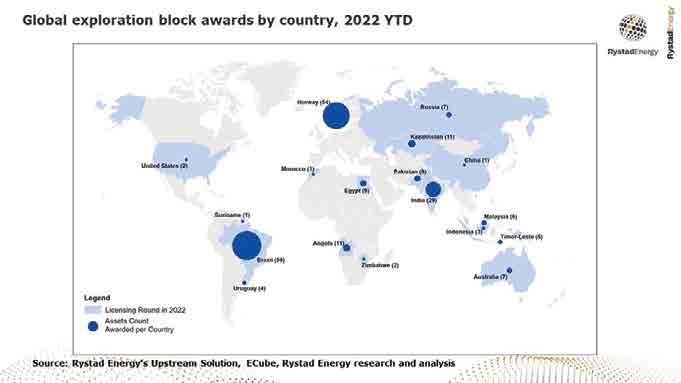
Only 21 lease rounds were completed globally through August this year, half of the 42 rounds held in the first eight months of 2021. The acreage awarded so far this year has shrunk to a 20-year low of 320,000 square kilometres. Global lease rounds are expected to total 44 this year, 14 less than in 2021 and the lowest level since 2000.
Global spending on exploration has been falling in recent years as oil and gas companies seek to limit risk by focusing on core producing assets and regions with guaranteed output, aiming to streamline their operations and build a more resilient business amid market uncertainty and the threat of a recession.
The political landscape is also contributing to the decrease in license awards, with many governments pausing or halting leases and encouraging companies to wrap up exploration activity within already awarded blocks. This trend is likely to continue as governments are less eager to invest in fossil fuel production and instead look ahead to a net zero future.
“Global exploration activity has been on a downward trend in recent years, even before the Covid-19 pandemic and oil market crash, and that looks set to continue this year and beyond. It is clear that oil and gas companies are unwilling to take on the increased risk
associated with new exploration or exploration in environmentally or politically sensitive areas,” says Aatisha Mahajan, Rystad Energy’s vice president of upstream analysis.

The onshore exploration sector is a significant contributor to the decline in awarded acreage. Total onshore acreage awarded in leasing activity has plummeted from more than 560,000 square kilometres in 2019 to a mere 115,000 square kilometres so far this year. Offshore leased acreage also hit a high point in 2019 before dropping off a cliff in 2020 and has remained relatively flat in the past two years.
Concluded lease rounds have dropped significantly in Russia, the US and Australia this year. These countries have held five lease rounds put together so far this year –three in Russia and one each in the US and Australia – down from 17 rounds in the first eight months of 2021 (eight in Russia, five in the US and four in Australia). The drop in the US is primarily driven by the cancellation of Lease Sales 259 and 261 in the Gulf of Mexico and Cook Inlet in Alaska.
Asian licensing has bucked the trend with increased activity and blocks awarded
10 Industry Europe FOCUS ON – ENERGY & UTILITIES
in Malaysia, Indonesia, India and Pakistan. The global decline in licensing rounds has directly affected the awarded acreage, which has hit an all-time low for the January to August period of about 320,000 square kilometres.
The decline in leasing activity has resulted in a considerable drop in Russian acreage awards, falling 90% from a year ago to 9,000 square kilometres, while licensed acreage in Africa shrank 70% to just 46,000 square kilometres spread across Angola, Egypt, Morocco and Zimbabwe, the only African countries to award new exploration acreage to date in 2022. On the other hand, new acreage awarded in Asia between January and August nearly quadrupled from the


same period last year, while South American awarded acreage surged by 140%.
Drilling into the awards
Brazil is the largest contributor in terms of blocks awarded so far this year, with 59 auctioned during its Third Permanent Offer Round. European majors Shell and TotalEnergies took all eight offshore blocks on offer – six and two, respectively. The remaining 51 onshore blocks in the Tucano, Espirito Santo, Potiguar, Reconcavo and Sergipe Alagoas basins went to regional players

3R Petroleum (six blocks), NTF (two), Petro Victory Energy (19), Origem Energia (18), Imetame Energia (three), Petroborn Oleo (two) and CE Engenharia (one).
Other sizeable block awards after Brazil were Norway with 54 new licenses in its APA 2021 round, India with 29 blocks in its OLAP Rounds 6 & 7, and Kazakhstan’s fourth oil and gas auction round, in which 11 blocks were awarded. There was also some sporadic activity in Africa between January and August, with Egypt providing rights to explore in nine blocks and Angola granting two blocks. South America also saw an offshore licensing round in Uruguay, where three exploration blocks were awarded – blocks OFF-2 and OFF-7 to Shell and Block OFF-6 to US independent APA. Challenger Energy signed a 30-year license for OFF-1 through direct negotiation with the government. n
Industry Europe 11
UPLIFTING PERFORMANCE
ASCO, a supplier of the design and manufacture of high-lift structures, complex mechanical assemblies and major functional components, is thriving as a member of Montana Aerospace, a world leader in the extrusion of high-strength aerospace alloys.
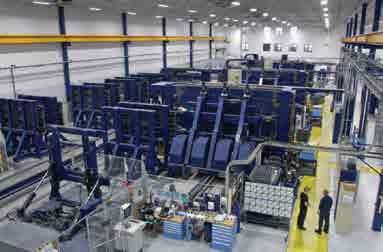







Belgium-headquartered ASCO was founded by Emile Boas Senior and operated as a family-owned business for decades, building worldwide recognition and know-how as an industry benchmark for the design, development, manufacture, treatment, and assembly of complex high-lift mechanisms and critical structural (sub-)assemblies, such as large and complex fuselage and wing and landing-gear components, made of lightweight materials.
Historically, ASCO has worked exclusively on commercial aircraft programmes, becoming the preferred partner for the design and manufacture of enhanced ‘Lift and Landing’ solutions for most of the world’s commercial aircraft fleets. More recently, ASCO has also become a primary supplier within several modern military aircraft programmes for primary critical structures.
ASCO has worked hard to diversify its customer base within the international aerospace industry, through its ability to offer engineering solutions in a competitive landscape. Today, its products are incorporated in most of the world’s aircraft, including commercial jets, regional and larger business aircraft, with the customer base including Airbus, Boeing, Bombardier, Embraer, Cessna, Lockheed Martin and others.


The company makes it clear that the continuous development of innovative products and services has not only helped its cus-
tomers meet their objectives but has the added benefit of helping ASCO produce a leaner organization and use more environmentally friendly manufacturing techniques whilst securing long-term financial strength to the benefit of all stakeholders.
Under new management
Last year, the company reached a significant milestone – in April 2022, ASCO announced that its acquisition by Switzerland-based Montana Aerospace, a manufacturer and supplier of structural parts and assemblies, had been completed.
As declared by Montana Aerospace, the combination of ASCO’s and Montana Aerospace’s competences will accelerate growth and reinforce the group’s standing as a strong industrial company wellequipped to meet the customer needs of tomorrow.
Under the new owner, ASCO is set to look for new opportunities to develop high technology solutions for new aircraft platforms, boosting its research programmes to include the development of new concepts using innovative materials and processes.
This focus will be fully supported by the company’ new Chief Executive Officer. Six months ago, the company’s former CEO and owner, Christian Boas, grandson of the company founder, stepped down from his role. His position was assumed by Olaf Lawrenz, an
AEROSPACE & DEFENCE
international manager with over 30 years of experience in the aerospace industry, working for Airbus & Premium AEROTEC, who is set to keep ASCO’s path to success on a steep upward trajectory.
Multi-year contract
Olaf Lawrenz stated that he will focus on a fast and smooth integration of ASCO into the Montana Aerospace Group and on preparing for the ramp-up within different programmes.
ASCO will also benefit from Montana Aerospace having achieved another successful year in 2022. Despite the challenges of rising costs and uncertainties in the supply chain, the group has managed to exceed its own expectations. Especially in the fourth quarter of 2022, net sales developed very positively compared to the previous quarters.
At the end of last year, Montana Aerospace scored a significant success by winning another new contract with Airbus for the production of extruded aluminium profiles. The multi-year contract with Europe’s largest aircraft manufacturer will start in 2023.
Montana Aerospace will supply Airbus with structural components for the fuselage and wings of the Airbus A320 to A350 with component lengths of up to 18 meters to be manufactured in the company’s large-format aluminium presses.
With this order from Airbus, Montana Aerospace’s third large-size, heavy press – built and commissioned in just 18 months and the first of its kind in Europe – will start series production in Romania. This new technology deployed in its Romanian plant will enable Montana Aerospace to support its European customers in their local4local procurement strategy.
Promising future
In addition to the expansion and development of the extrusion business in Europe, Montana Aerospace has also invested heavily in the development of its one-stop-shop strategy, expanding its service and product portfolio in the area of complex, critical components. The company is currently in the final stage of its extensive investment programme worth over 600 million Euros.

14 Industry Europe
Kai Arndt, Co-CEO of Montana Aerospace AG , commented on the recent achievements: “Market share gains from the recent acquisitions of ASCO and São Marco, the second largest magneto-wire manufacturer in Brazil, completed in 2022, as well as the recovery and trend reversal in the industry, will continue to drive our growth.”
“Montana Aerospace has invested heavily in expanding competencies and capacities in recent years. With the new order from Airbus, we feel confirmed in our strategy of expanding the extrusion business in Europe, in order to serve our customers locally and to support them in the implementation of their ambitious increase in construction rates.”
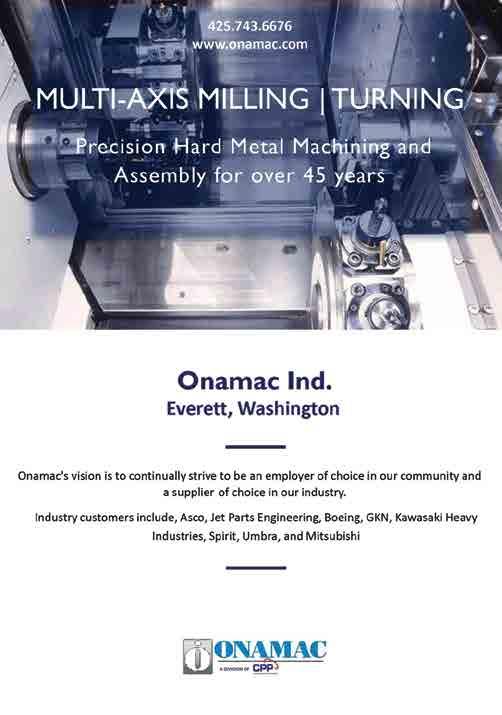

“Looking to the future, we are confident that we can continue our dynamic growth strategy as we always focus on delivering the highest quality to our customers and reliably stepping in where other suppliers struggle, “ he concluded. n

AEROSPACE & DEFENCE
New developments in the Aerospace & Defence
displays
The order value amounts to SEK 69 million with deliveries in 2023-2025. MilDef's agreement with a partner in the defense industry concerns the development and delivery of products for tactical communication and enhanced cyber defense. The collaboration involves development work and delivery of a large volume of hardware units. The modernization of the current defense system concerns replacing older technology with MilDef's products, as part of the system's

capability increase. Each system is equipped with several 19/2 computers, switches, panel PCs and ruggedized laptops.
“MilDef and many other defense companies are stepping up their cooperation. This collaboration combines two Swedish defense companies that are specialists in their respective fields. MilDef is trusted to contribute with our cutting-edge expertise; to deliver future-proof IT systems that strengthen the protection of our society," says Björn Karlsson, CEO MilDef Group.
New partnership will take tourists to the stratosphere by balloon
French space startup Stratoflight and global tech and engineering company Expleo have announced a partnership for the development of a new zero-carbon footprint spacecraft that will take passengers to near space.
Stratoflight is a new sustainable mode of transport that will allow passengers to reach the stratosphere - 35km above ground level - in a unique capsule complete with an “external” viewing platform.
For its ascent, the spacecraft uses tried-and-tested zero-pressure balloon technology, filled with green hydrogen, like that used for many years by space agencies such as CNES and NASA for scientific flights. To ensure a zero-carbon footprint, hydrogen will be produced locally at the take-off site via renewable energy, including solar and wind.
The vehicle, which measures 8m in length, 4m in width and 3m in height, can accommodate up to six people, including two pilots.
Reservations for passengers will open in early 2023, with the first flight scheduled for 2025.
Expleo is designing the flight capsule for Stratoflight, which includes an extra-vehicular viewing platform, or “balcony”. Passengers wearing a pressurised suit will be able to step out into space to view the Earth from the stratosphere, at an altitude where the planet’s curvature will be visible and a horizon spanning from Barcelona to Amsterdam is visible, approximately 1239km.

Engineers at Expleo’s innovation laboratory had to consider numerous parameters to ensure a safe and immersive experience for passengers in a capsule with large glass areas in its structure, including structural sizing, interior and exterior panels, design of onboard electronics, safety, and aerodynamics.
The cockpit, made of bio-sourced, recycled or recyclable materials, will be able to fly at speeds of up to 140 km/h for the return to land, thanks to its aerodynamic shape with both straight and curved lines. Descent to land is made under a piloted paraglider.
The programme is being developed with several European partners, including Swing for the parachutes and Spartan Space for the pressure suit.
Arnaud Longobardi, airline pilot and co-founder of Stratoflight, said: "Stratoflight provides passengers with multiple exceptional experiences: the ascent to space that feels like a hot-air balloon flight, stepping out onto the viewing balcony, moving into space like an astronaut, and the landing, similar to free flight in a paraglider; all this in a capsule similar to a spacecraft. For me, this mission is not only the realisation of my dreams as a pilot but also a technological innovation respectful of the planet.”
"Making space accessible to all, while respecting the environment, is at the heart of what we believe in at Expleo. Our teams of space engineers have designed this capsule with this dual objective in mind. And we intend to go further. We are currently investigating the possibility of making the capsule out of new green composite materials based on bamboo, which would further reduce its carbon footprint. We are proud of our work with Stratoflight and of our contribution to this innovation," said Frédérique Rebout, Head of Space, Expleo.
Stratoflight will also offer, each year, several flights to people involved in the areas of preservation of Earth, science and space, in the world of education, and in the charity sector. For more information, visit: www.stratoflight.fr
16 Industry Europe NEWS
In connection with the delivery of replacement technology and modernization of a Swedish defense system, MilDef has been entrusted to deliver rugged computers, switches and
MilDef rugged computer 19 inch 2
The Expleo-designed capsule includes an extravehicular viewing platform that allows passengers to step out into space
From Sicily to Mars: Drone & rover tests pave way to the red planet
US-based
drone company Skypersonic, which in 2021 entered into a five-year contract with NASA to provide drone and rover hardware, software and support to the space agency's simulated Mars mission, has successfully completed testing on Mount Etna, an active volcano in Sicily where the landscape is similar to Martian geology.
Skypersonic says that the 15-day test demonstrates how its Skycopter drone can be piloted virtually anywhere, from virtually anywhere.

Using Skypersonic’s Long Range Real-Time Remote Piloting System, the drone and rover on Mount Etna were controlled by personnel in Houston, Texas, in real-time.
While most drones cannot be piloted without connecting to the GPS network, Skycopter uses technology that is able to control and track the drone in locations – such as Mars – where GPS is not available.
"This was a gruelling test that we passed with flying colours. We look forward to the ultimate test – on Earth, at least – when our technology will be used during NASA’s upcoming yearlong simulated Mars mission. We are confident of also passing this test," said Skypersonic CEO
 Giuseppe Santangelo
Giuseppe Santangelo
working in a 1,700-square-foot module on Earth, called Mars Dune Alpha,
will carry out a series of missions – including remotely guided exploration and collection of specimens from rugged terrain elsewhere on Earth, up to thousands of miles away."
The test results on the volcano included sample collections made by the rover - an essential capability for robotic exploration of Mars.
The project was a collaboration between Skypersonic, the University of Turin and Etna Park.
Snew project that aims to identify appli cations for its origami-inspired manufacturing technology in outer space.
The startup, which has become known for pushing the boundaries of design and innovation, is working with Sweden’s International Space Asset Acceleration Company (ISAAC) to discover how Stilfold’s “origami” manufacturing tech can be used for transporting and constructing materials in space.
A new organisation, ISAAC was founded by entrepreneur Mattias Hansson and backed by the European Space Agency and Sweden’s first astronaut Christer Fuglesang, and aims to strengthen innovation using knowledge and discoveries from outer space.
network of resources and specialist expertise to support them as they develop their technology for space. Over the next twelve months Stilfold will explore how their technology could be used for interior design solutions, transporters and food assembly in outer space, as well as how they can leverage existing space technologies to develop the perfect metamaterial for use with the Stilfold technology, both on Earth and in space.
Stilfold’s pioneering technology, dubbed “industrial origami”, involves the use of robotic arms to fold sheets of steel over curves to form intricate and lightweight new shapes. It is particularly well-suited to the limitations of space, as it enables the construction of strong and complex structures
stamping or welding. This has the potential to make it easier for astronauts to transport, preserve and construct resources.
Stilfold is currently being used by daughter company Stilride to build a sustainable steel e-motorcycle - but the potential applications for the technology are huge.
“We are constantly looking for new ways to innovate and push the boundaries of our technology, and exploring the possibilities of taking the concept into space feels extra exciting. In our quest to find materials and solutions that have a minimal environmental impact, it is also incredibly exciting to be able to leverage the research and innovation that has taken place and is taking place around space travel to explore new potential applications for Stilfold,” said Jonas Nyvang, CEO and co-founder at Stilfold.
Christer Fuglesang, astronaut and senior advisor to ISAAC added: “The results of the extremely advanced work that goes into getting us into space is knowledge and technology that can also be used to create better conditions for us humans on our beautiful blue planet."
Cecilia Hertz, co-founder of ISAAC, said: “Space travel places very high demands on the material being transported. Any solutions that can help us streamline and improve this are of great interest to the industry as a whole.”
For more information, visit: www.stilfold.com
Industry Europe 17 NEWS INDUSTRYNEWS
AEROSPACE & DEFENCE
Stilfold will take “industrial origami” tech into orbit
The Skycopter. Credit: Skypersonic
New developments in the Chemicals & Biochemicals
BRUGGOLEN®
TP-H2217 belongs to a new class of electrically neutral thermostabilisers from Brüggemann. Specially developed for reinforced and unreinforced aliphatic polyamides with metal- and halogen-free flame retardancy requirements, it ideally meets the needs of electrical and electronic applications, including those of e-mobility. Despite its high efficiency it neither has a corrosive effect on metallic components such as overmoulded sensors, nor does it influence the electrical properties of the polymer it is protecting in any significant way.
New metal- and halogen-free stabilisers from Brüggemann are designed to meet the increased requirements coming from the electrical and electronics industry and especially e-mobility. © Brüggemann.
The high efficiency of long-term stabilisation is demonstrated by the example of a PA6.6-GF30. After 8,000 h of heat storage at 170°C, the tensile strength values are still over 50%.

A key requirement of any additives used in e-mobility applications is that the flame retardancy properties of those applications are not harmed. BRUGGOLEN® TP-H2217 is neutral in this respect as is Brüggemann’s new flow enhancer, BRUGGOLEN® TP-P2201, which is used to process glass-fibre reinforced polyamides into thin-walled and complex components with long flow paths.
Dr Kristina Frädrich, Product Manager at Brüggemann, comments: "With BRUGGOLEN® TP-H2217, compounders can for the first time produce polyamide materials that combine a UL94 V-0 classification, electrical neutrality as well as permanent heat resistance at elevated temperatures, and are thus specially tailored to the increased requirements of e-mobility. With this combination, which neither phenol- nor amine-based grades can offer, Brüggemann raises the bar for thermo-stabilisers by a considerable margin."
BRUGGOLEN® TP-H2217 is available as an easy-to-process masterbatch in granular form, with a level of 3% proving sufficient for many applications in laboratory trials.
Sulzer Chemtech’s crystallization technology helps drive DSI’s growth
Song Ho Kim, President of DSI, says: “We are extremely happy with the collaboration established with Sulzer Chemtech. Their solution for crystallizing naphthalene is a leader in the market, so when looking at advancing our offering, we were confident we should invest in this technology. The flexibility of our operations will also be improved, helping us address different market needs while optimizing operational expenses and profitability. We look forward to installing the unit and beginning our first-grade naphthalene operations shortly.”
can be used that can be used for applications with stringent quality requirements.
DSI’s facility in Serang processes naphthalene from coal tar to deliver the valuable chemicals. To this end, the plant has been producing naphthalene related products.
In order to increase the purity level of its raw materials and end products as well as serving the broader downstream sector, the company
sors worldwide, enabling them to deliver high quality aromatics.
Prior to the delivery of the purification unit, Sulzer Chemtech completed extensive feasibility and pilot testing ahead of its basic engineering package. This helped ensure DSI to produce different concentrations, including levels of up to 99.9 wt% at an overall production capacity of 7’000 metric tons per annum.
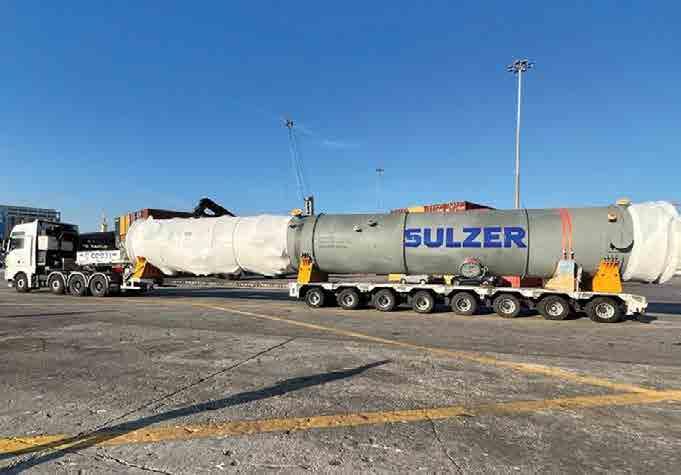
Etienne Rigaut, Head of Crystallization at Sulzer Chemtech, adds: “For decades, we have been supporting the most challenging separation processes with state-of-the-art crystallization equipment. Thanks to our extensive expertise, combined with testing and engineering capabilities, we have been able to deliver a customized unit that will help DSI enhance its competitiveness in the marketplace. We strive to support our customers and the entire sector with cutting-edge technologies.”
Visit: www.sulzer.com
18 Industry Europe NEWS
New copper and halogen-free long-term heat stabilisers tailored for applications in E&E and e-mobility
Precise gas mixtures even at high flow
For applications needing high flow rates of gas mixtures, such as steel production or the chemical industry, WITT offers the MG 2000ME ERC+ electronic gas mixer. Precisely and reliably, the device generates high-quality gas mixtures of two technical gases, even when the flow rate is fluctuating.
Inside the new top model from the market leader is an electronically operated proportional valve that achieves a maximum mixed gas output of up to 2,180 Nm3/h. The system is controlled either remotely via Ethernet or analog output, or directly on the unit via an intuitive touchscreen. The seamless mixture adjustment is thus particularly precise, and stored mixture specifications can be easily reproduced. When operated remotely, the user can control and see the system status at any time and from anywhere in the world.
The system keeps the mixture and outlet pressure stable, even when the flowrate is changing. In this way, the user obtains a precise mixture over the entire output range, even with cycling flowrates.
Certainly the correct gas mixture
With its numerous features, the WITT gas mixer ensures a particularly high level of process reliability. Pressure fluctuations in the gas supply are compensated by a constant pressure control and have no influence on the mixture quality. Optional pressure and temperature transmitters monitor the gas supply. Excessively low inlet pressures or temperatures generate an alarm and shut down the system. The setting of the mixing valve is maintained even when the mixer is switched off. This means that after a restart, the required mixture is generated again immediately.
For even greater certainty, the mixer can be optionally equipped with an integrated gas analyser for monitoring and documenting the gas mixture.
High quality, flexibility and economy
Like all WITT gas mixers, the MG 2000-ME ERC+ offers the user major benefits : It reliably generates precise and absolutely homogeneous gas mixtures of the highest quality. In addition, it offers the highest possible flexibility with regard to mixing ratio, gas quantity and place of use. By using comparatively inexpensive standard technical gases, the on-site generation of mixtures with the low-maintenance WITT unit is particularly economical.
Depending on the requirements, WITT gas mixers are available in various designs for almost all technical gases and different performance ranges.
Visit: www.wittgas.com
Beyond Ionomers: Regulation Drives Demand for New Fuel Cell Membranes, Finds IDTechEx Research
Membrane materials are of fundamental importance for fuel cells. So significant, in fact, that they typically give their name to the fuel cell, as is the case for Proton Exchange Membrane (PEM) fuel cells, with IDTechEx forecasting the market for ion-exchange membranes in PEM fuel cells to be worth over US$1.1 billion by 2033. Typically, the material of choice for PEMs is an ionically conducting polymer known as an ionomer. These ionomers are one of a family of perfluoroalkyl substances (PFAS), and concerns are mounting regarding PFAS, with alternative materials beginning to emerge.
The new IDTechEx report, "Materials for PEM Fuel Cells 2023-2033", gives a detailed technical overview of membranes and other key components for PEM fuel cells, an analysis of the major players, and also includes granular 10-year market forecasts for key fuel cell components and materials in terms of both units and volume. IDTechEx has also extensively covered the electric vehicle industry and forecasts demand for fuel cell electric vehicles (FCEVs) in "Fuel Cell Electric Vehicles 2022-2042".
The PEM enables the functionality of the fuel cell by transporting protons from one side of the cell to the other while keeping the different fuels separated. In the report, IDTechEx provides extensive benchmarking of the market leader against competing ionomer materials for three of the most critical parameters for PEMs; electrical resistance, ion exchange capacity (IEC), and membrane thickness. Despite transporting protons, it is imperative that the membrane has high electrical resistance to avoid short-circuiting the cell, while the combination of high IEC and thin membrane increases the fuel cell performance by enabling rapid proton transport. Promising alternatives exist, with performance exceeding the market leader in the three previously mentioned categories; however, the latter remains dominant due mainly to its position as the first mover in the market. Although dominant, ionomers are a PFAS-containing material and are subject to many of the concerns relating to PFASs. PFASs are considered "forever chemicals" due to the strength of the fluorine-carbon bond, with several health risks associated with accumulation in the human body, such as liver damage,
kidney cancer, and reduced response to vaccines. PFASs are transferred to the water cycle during their manufacturing stages, use in industrial processes and end-of-life treatment, leading to inevitable exposure for organisms. Bioaccumulation occurs in the tissue of organisms, such as fish in polluted waters, and this is then transferred up the food chain, including to humans.
On the back of these current and proposed restrictions, many companies are moving to reduce their reliance on PFASs. An interesting case study is the American company 3M. Having produced PFASs since 1947, 3M announced in December 2022 that it will cease the manufacturing of, and work to discontinue the use of, PFASs by 2025. 3M cited regulatory restrictions, consumers becoming "increasingly interested in alternatives" and operational difficulties as primary reasons for exiting the PFAS market.
So, what does this mean for fuel cells? Ultimately IDTechEx expects to see the beginning of a transition away from PFAS membranes to alternatives (including hydrocarbons) within the next three to five years. Prototype developmental projects are underway with various OEMs and novel materials gaining traction, predominantly at an academic level, such as metal-organic frameworks (MOFs), although these materials are still at an early stage with little commercial uptake. Historically, hydrocarbons have not seen success as membrane materials due to their tendency to disintegrate in the harsh chemical environments within the fuel cell. However, recent advances at companies such as Ionomr Innovations have seen the development of hydrocarbon ion-exchange membranes capable of fulfilling the requirements for PEM fuel cells without the health and environmental concerns associated with PFAS chemistry.
For more details on the materials demand, trends, and emerging novel alternatives to the incumbents for PEM fuel cells, please see the IDTechEx market report "Materials for PEM Fuel Cells 2023-2033". For more information on IDTechEx's other reports and market intelligence offerings, please visit www.IDTechEx.com.
Industry Europe 19 NEWS
INDUSTRYNEWS
CHEMICALS & BIOCHEMICALS
New developments in the Construction & Engineering
Ferrovial to build €245m port terminal in Gdańsk, Poland

Through its Polish construction subsidiary Budimex and in consortium with Dredging International, Ferrovial will begin work on the new terminal at DCT Gdańsk starting in September this year.
The contract for the new terminal, known as T3, will see the construction of a deepwater pier, drainage works and the building of a 700-metre-long mooring front that will be able to accommodate the largest container ships currently in service.
marine life and habitats in the area influenced by the construction.
“Once complete, the terminal will be the most advanced of its kind in the Baltic Sea and will reflect our commitment to sustainable investing and operating, with reduced CO2 emissions both from the construction, and the equipment we will deploy for future operations.”
Theconstruction of a new container terminal at the Port of Gdańsk in Poland is to go ahead later this year, after port operator DCT Gdansk chose a consortium led by Spanish infrastructure company Ferrovial to carry out the €245 million project.
T3 will span 360,000m2 with a depth of 17 meters, making it one of the largest container terminal hubs in Europe.
Charles Baker, CEO of DCT Gdańsk, said, “During construction, we will take all precautionary measures to protect the environment,
According to port operator DCT Gdansk, which saw its highest amount of container throughput earlier this year, the completion of T3 will increase the port of Gdansk’s capacity by 1.7 million containers a year, up to a total 4.5 million.
The project will take three years to complete, with the final works currently expected to be completed by the first half of 2025.
Sustainable homes: Why eco-friendly homes are top of house buyers' lists

Sustainability remains a buzzword. Being greener and sustainable and becoming eco-friendly are topics that remain popular. In today's world, more people want to be sustainable and live a greener lifestyle. The UK's green economy is continuing to rise. It is now reported to be four times larger than the manufacturing sector. This rise is not likely to slow down anytime soon. The calls for measures to be put in place to help reduce carbon emissions and lower our carbon footprint is becoming increasingly urgent.
It is not just how companies can lower their carbon footprint or what the government can do to help with the fight against climate change. Sustainable homes have become a popular choice for many homeowners and potential buyers. Homeowners are prepared to invest in renovation work to help their homes be more sustainable. As a result, potential buyers want to purchase a property with many sustainable elements and eco-friendly aspects.
Withstand The Elements
The drastic weather the UK has experienced in the past few months and years is a glimpse of the impact of climate change. The recordbreaking high temperatures and storms causing floods have led many people to want to update their homes to ensure they can withstand these extreme elements. Of course, many want to ensure any changes to their home are made with sustainable materials or appliances.
For example, if you want to create a shaded area at the back of your house where you can sit outside but hidden from the sun, you might want to add corrugated roofing. You can look into corrugated roofing from ClearAmber Shop and see how durable the polycarbonate sheets are. Corrugated roofing is ideal for those wanting to have a social area in their back garden but wants it to have shelter to allow privacy and some shade during those warm summer days. With corrugated roofing, the materials it is made from can help to withstand the harsher elements that the UK has been experiencing. In the morning following a stormy night, it is likely that your shaded social area will still be standing.
Likely Have Lower Bills
A common advantage of a sustainable home is that they feature many energy-saving appliances. If any renovation work has been done to the property, they might have aimed to make it as sustainable as possible. Energy-saving appliances can help more than just the environment. Many people invest in energy-saving appliances as they can help to lower their monthly energy bills.
In today's current climate, when prices are rising, finding ways to save is becoming a top priority for many. If having sustainable features in their home can help, many people will be happy to invest. It might take time before a difference in how much is saved, but the amount will likely be noticeable after an extended period.
Worthwhile Investment
It is often said that investing in sustainable appliances is worthwhile. Of course, it can take time before it is noticeable. However, once the cost of bills begins to decrease, you begin to see the difference a sustainable home can make. The cost of living is rising, and numerous factors contribute to this. Energy bills are just one of the many monthly costs that are slowly increasing. Traditional homes are less sustainable, and the energy costs for these properties can be steep. Living in a sustainable home can help to combat this issue. It is one of the reasons why so many wish to live in a sustainable home.
The Bottom Line
As mentioned, the reasons for wanting a sustainable home continue to grow along with the increased pressure to make changes to help tackle climate change increases. Investing in a sustainable home offers a quality home that will save money and help create a brighter future. Sustainable homes are becoming more common as property developers see the increasing demand for sustainable properties. It is likely to be a trend for many years to come.
20 Industry Europe
NEWS
Unknown Unknowns: WASP's 3D printing exhibition opens in Milan
by Steven Gislam
Oneof the most important international events devoted to design and architecture, the 23rd Triennale Milano International Exhibition opened earlier this month, celebrating 100 years since its foundation and featuring a unique exhibition by 3D printing company WASP.
Triennale's thematic exhibition Unknown Unknowns examines a range of themes including:
• Gravity - “The greatest designer”, an artisan that tirelessly shakes the universe in which we live;
• Maps - Systems with which trajectories and routes are determined;
• New challenges facing architecture - The sector is opening itself up to brand new prospects such as extraterrestrial living and, ultimately, the mysteries linked to deep space.
With the ongoing themes of sustainability and reusability as a backdrop, Unknown Unknowns was designed by Space Caviar and produced by WASP. Created wholly using 3D printing with large printers on an architectural scale and with only organic materials, largely waste from the food industry. For the first time, the exhibition pieces were
completely produced inside the museum itself, with 32 different pieces being printed in only 10 days.
Taking inspiration from the potter wasp, which builds its home using materials found on the spot, the company has been developing new, viable construction processes and techniques based on the principles of the circular economy to create 3D printed houses quickly and sustainably using biodegradable, recyclable and locally-sourced natural materials.
For this project WASP used the architectural 3D printer Crane WASP. It is a modular collaborative 3D printing system composed of a main printer unit that can be assembled in different configurations depending on the printing area and therefore on the dimensions of the architectural structure to be calculated in 3D.
For the needs of this specific setup, WASP transported and assembled Crane WASP within the museum and mixed the material near the printer on the first floor of the Triennale.
The company says that Unknown Unknowns is a "brilliant example of how WASP technology is declinable and multidisciplinary".
The thematic exhibition, Unknown Unknowns, is curated by Ersilia Vaudo, an astrophysicist and Chief Diversity Officer at the European Space Agency, and will be on display at the Triennale Milan until 11 December 2022.
Caverion & ABB partner to advance smart carbon-neutral buildings
Finnish sustainable building company Caverion has partnered with Swiss-based tech giant ABB to accelerate the development of energyefficient and sustainable buildings.
The two companies cite the collaboration's aim is to bring advanced, smart solutions for achieving carbon-neutral buildings and reaching their sustainability targets.
ABB’s technology will be brought together with Caverion’s sustainable solutions and system integration capabilities and will expand both companies' presence in Northern Europe.

The results of the partnership could be utilised in new buildings and modernisations to make them more automated, intelligent and sustainable in line with evolving customer demands. Optimal conditions in smart buildings increase also the end-user well-being and satisfaction.
“The agreement with Caverion demonstrates ABB’s ongoing commitment to enabling a carbon neutral society through the power of collaboration. Our joint capabilities will enable customers in the Nordics and beyond to benefit even faster from the latest in innovative smart building technology according to their individual sustainability requirements,” said Uwe Laudenklos, Marketing & Sales Leader for Europe, Canada, and Francophone Africa (ECAF), ABB Electrification’s Smart Buildings division.
"We at Caverion want to create sustainable impact for every customer with the solutions we design and deliver. We are excited to expand our collaboration with ABB as we share common goals toward a sustainable, carbon-neutral society. Together, we will provide our customers with stateof-the-art solutions for energy efficient and sustainable buildings," added Kari Sundbäck, Head of Services, Solutions, Digital and Sustainability of Caverion Group.
ABB's Mission to Zero programme will form a major part of the collaboration. The programme is intended to be a scalable blueprint for smart building solutions combined with onsite renewable energy generation and storage. The key components of the Mission to Zero vision are to accelerate carbon neutrality and energy self-sufficiency through the use of metering & energy management solutions linked to electrification, distributed energy resources technologies and enhanced by renewable energy procurements.
Visit: https://global.abb/group/en
Industry Europe 21
NEWS
NEWS CONSTRUCTION & ENGINEERING
INDUSTRY
THE SMART CHOICE
With its three divisions, the Franke Group, a leading global supplier of products and services for domestic kitchens, foodservice systems and the convenience store sector, is staying ahead of trends.
With over 60 companies, the Franke Group is at home on five continents. Headquartered in Aarburg, Switzerland, Franke Group employs approximately 10,500 staff across Europe, South and North America, Africa, Australia and Asia.
Franke Home Solutions was born in 2021 as a new division of the Franke Group, aiming to expand the presence of the company in the kitchens sector. The new name Franke Home Solutions is intended to be synonymous with food preparation (sinks and taps) and cooking (hoods, hobs and ovens), while it is also intended to reflect the desire to exploit the division’s expertise to increase its presence in the kitchens sector.


Drawing on the Group’s solid tradition. the Swiss kitchen and foodservice equipment manufacturer is standing strong in the volatile market environment, with a sound financial performance and new, innovative products that have been designed to reflect the latest trends supporting sustainability and energy savings.
Positive performance
The company reported that overall it has weathered the ongoing supply chain bottlenecks and rising inflation well. The Group was
22 Industry Europe


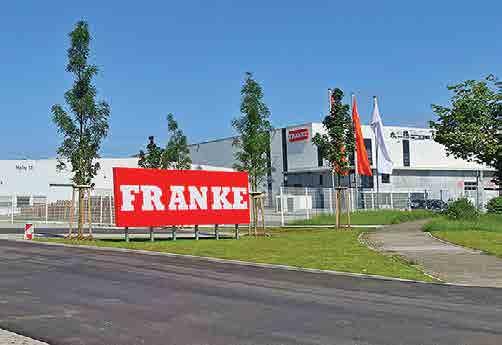
CONSUMER GOODS
not only able to supply customers as planned, but also to pass on price increases, thus partly compensating for higher raw material, component and transport costs.

The Franke Foodservice Systems and Franke Coffee Systems divisions were cited as positive contributors, while revenues for Franke Home Solutions fell. This was a contrast to 2021, when the latter had the largest sales growth within the company, at 41.1%.
The results highlight a shift in consumer demand for at-home coffee equipment following a sharp rise in the market during the pandemic when out-of-home coffee shops were repeatedly shuttered. The Group warned that a ‘fragile’ geopolitical and economic situation is expected to continue to further disrupt supply chain operations and lead to higher prices.
Awarded solutions
Despite the challenges, Franke continues to be committed to innovations. For over 110 years, Franke designers have prided them-

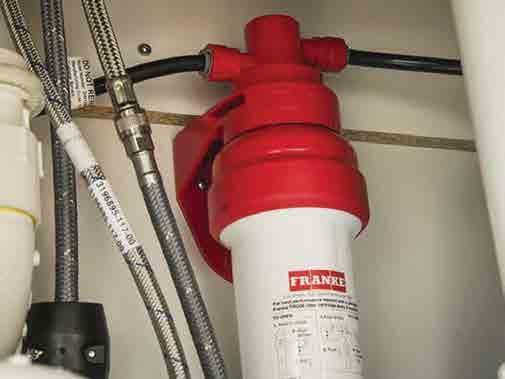
selves on their craftsmanship when developing high-quality Swissmade products. Timeless yet contemporary design has remained at the forefront of innovation at Franke, a promise that has been recognised globally with over 120 awards.
Several of Franke Home Solutions’ products collected (again) the Best Red Dot awards in 2022, including the innovative Active Twist Tap, specially designed to link the tap and sink with a dial that, when turned, operates the waste outlet, enabling the water to drain away easily, safely and hygienically. It received this prestigious award for its unique functionality and equally striking aesthetics, which feature a matte black finish.
Red Dot Winners 2022 also included All-In, the flexible, modular food preparation system designed to bring more flow to the kitchen - Maris Fragranite bowls made from Fragranite, which lasts a lifetime, and treated with Sanitized, which contains silver ions that prevent germs, mould and bad odours.
Franke’s Smart Suspended Hood was also awarded – the hood hangs from three wires, lending it clean lines and an elegant shape, and it comes in three chic finishes. It uses a plug-in carbon filter that is easy to change, making it simple to use and maintain. It also has a Class A energy efficiency rating and an impressively low noise level.
Most recently, the company has collected yet another ward – its Mythos Masterpiece Collection has won the 2023 Kitchen Innovation Award, recognising innovation and attention to detail in all its products.
Transformed for a better living

To stay in line with market trends and to reflect the forward-looking company mentality, in September 2022 Franke Group started to roll out a new brand identity across all platforms, complete with the promise: ‘Franke transforms change into opportunities for better living’.


While reminiscent of the brand’s previous look, the updated Franke logo is in a bold ‘Vibrant Red’ tone, an evolution of the current brand colour, which the company says is for greater precision and adaptability.
“The new branding is more than just an updated look for the Franke Group – we relish change and see it as an opportunity to innovate and to keep improving. That’s why we have refined our brand positioning and why we are open to change,” said Patrik Wohlhauser, CEO of the Franke Group.
In concluding, he affirms that the company is boldly push the boundaries and drive forward innovations, so that Franke is always one step ahead. “Day in, day out, we strive to present the best pos sible ideas and solutions to respond to our customers’ ever-chang ing needs. Our new design is a clear expression of this ambition.”
Industry Europe 25
A CENTURY OF MARKET LEADERSHIP
With a history of over 100 years, a catalogue of more than 20,000 products and operations in over 100 countries worldwide, LOVATO Electric is standing strong in a volatile market.


26 Industry Europe
Established in Bergamo, Italy, in 1922, LOVATO Electric is a private company run by the same family for 4 generations. For over a century, the company has been designing and manufacturing low-voltage electrical components for industrial applications.


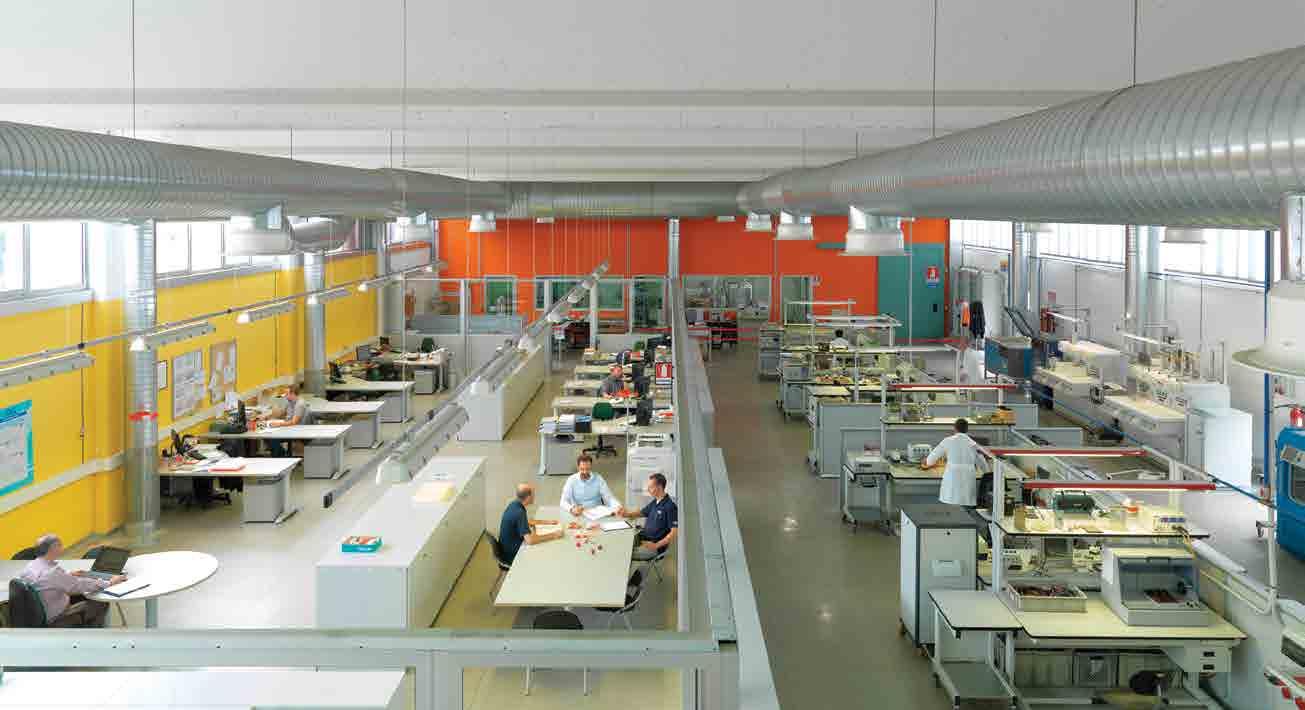
The product range includes motor protection circuit breakers, contactors, push-buttons, switch disconnectors, limit switches, digital multimeters, energy meters, soft starters, AC motor drives, automatic power factor controllers and engine, generator controllers and more.
“For four generations, our mission has been to create innovative and reliable products to satisfy the client’s requirements, and it continues to be so today,” said company CEO Massimiliano Cacciavillani, explaining that the company’s mission has always been to provide competitive products and services in industrial automation and energy management.
Responsible operation
Being close to its customers has been part of that mission. LOVATO opened its first factory outside Italy in 1979 and international expansion has continued until the present day. The company’s 15 international subsidiaries and a network of over 90 importers ensure the availability of LOVATO Electric products in more than 100 countries across all continents.
It is not only product excellent that is the focus of LOVATO’s management. The company is committed to the maintenance of social, environmental and management standards of the highest order. Its policies and measures are aimed at achieving the “Sustainable Development Objectives” set out in United Nations Agenda 2030. Within these objectives, a whole range of initiatives have been launched to support the staff and their development.

Industry Europe 27
CONSUMER GOODS
As part of the company’s efforts to safeguard and protect the environment, LOVATO Electric has adopted advanced eco-efficient solutions, technologies and equipment, including photovoltaic systems, high-efficiency plastic moulding presses with hybrid or electric power for a lower environmental impact, as well as in-house recycling of reject die castings and sorted waste management.

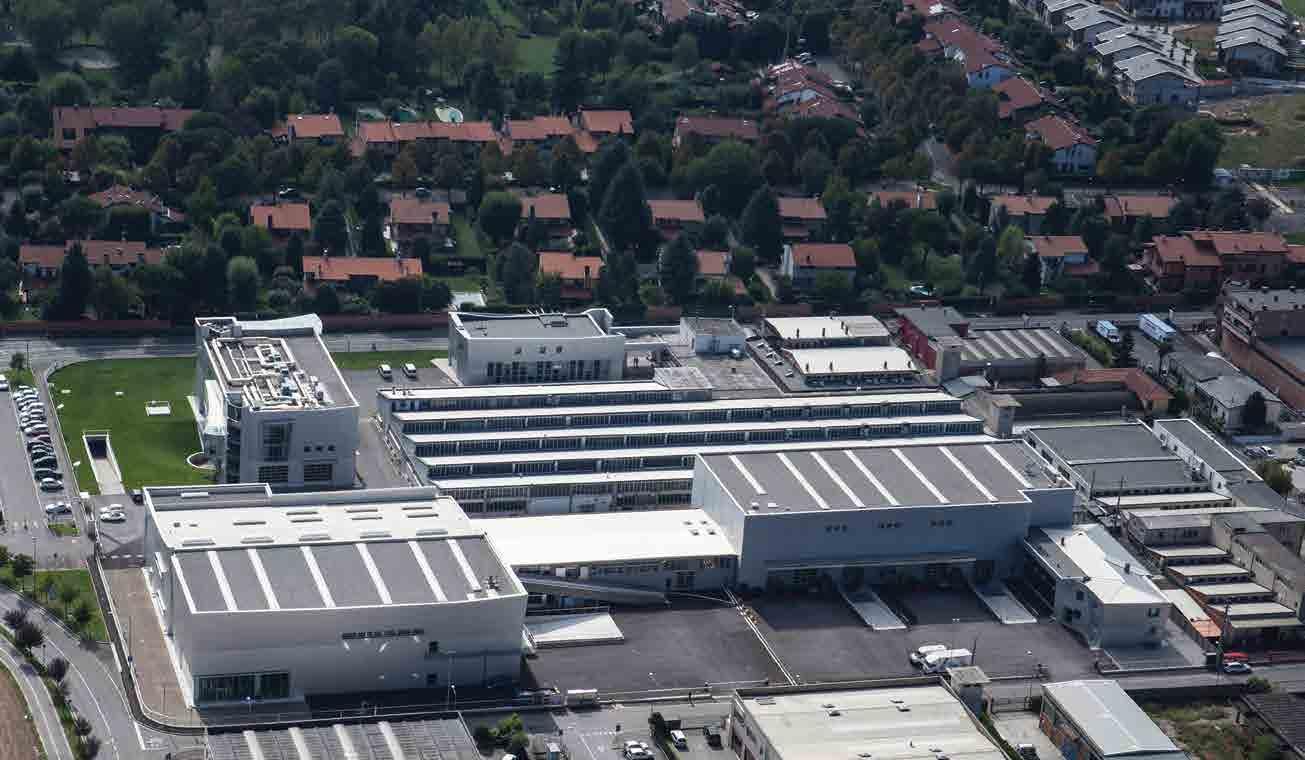
Driven by innovation
A focus on continuously innovating the product range is one of the factors that have pushed the company’s growth and expansion. LOVATO’s R&D laboratory, specialised in R&D testing, was born of the need to expand the company’s testing capabilities for the development of new high-performance products, ensuring the highest standards of safety and reliability while reducing time to market.
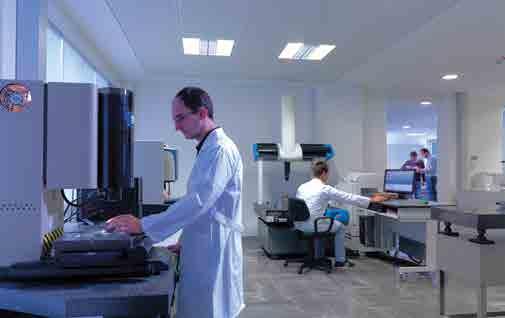
Recent innovations include, for example, the updated range of contactors with a new construction size. The new contactors are
rated 160A, 195A and 230A three-phase for motor control applications, and 250A, 275A and 350A in the AC-1 category. They are available in both 3- and 4-pole versions.
Also recently, the company has presented a new generation of power analysers with a widescreen LCD colour display that ensures clear, legible reading of the main analysis parameters, all while maintaining the classic drilling template (92x92mm). The result is perfect compatibility with standard front panel solutions. The measurements are displayed as waveform graphics, polar diagrams and harmonic spectra up to the 63rd order, thus offering everything needed to analyse the condition of the system.
Customers will also appreciate the ADXN series soft starters that are simple, compact and functional. The soft starters are ideal for applications which demand a simple, compact and easy-to-configure solution for gradually starting and stopping motors. Their versatility makes them adaptable to a variety of applications, including
28 Industry Europe
pump, fan, conveyor and compressor control, and they are available with current ratings from 6A to 45A.

Looking into the future
The focus on supplying best-in-class products has been one of the factors that have promoted the company to its leading position, a lasting success reflected in an important milestone achieved last year – in 2022, the company celebrated the first 100 years of its history. The celebrations officially started on September 10th with an event for all employees: a day dedicated to the company’s past, present and future.

The “Follow the Orange” event was staged in the prestigious location of the Donizetti Theatre in Bergamo: a journey through the milestones of these first 100 years of the company, narrated by Gianpiero and Massimo Cacciavillani, respectively President and CEO.
A journey that began in the early 1900s and that, over the years, has connected employees and stakeholders all over the world. Representatives from more than 100 countries around the world gathered for this unique event with a rich and varied programme in which corporate moments were followed by fun and convivial experiences, under the banner of Made in Italy.
“It was in the 1970s when we began to understand the importance of opening up to foreign markets and crossing national borders,” says Gianpiero Cacciavillani, President of the company.

“To see our company grow steadily and play a major role in the international industrial automation scene is a source of great pride,” he noted, affirming that LOVATO Electric will always look to the future, innovations and new challenges, but with a strong attachment to its territory. n

CONSUMER GOODS
Industry Europe 29
PREMIUM LEATHER FROM AUSTRIA
Wollsdorf, headquartered in the Austrian state of Styria, has become a recognised producer of leather products, shipped to customers around the world. Founded in 1937, the Austrian manufacturer draws on decades of experience and extensive know-how. Today the company produces high-quality, highly durable leather furnishings using both high-tech manufacturing processes and traditional craftsmanship.
Its diverse product range provides a high degree of flexibility and allows the company to individually address individual customers’
needs. Wollsdorf’s all-in-one solutions range from whole leather hides, leather cut parts, lamination and perforation serviced to ready-stitched and certified dress covers.
The automotive sector is the strongest market – here Wollsdorf’s products can be found on the steering wheel, car seats, dashboard, gear stick and more. The company also has a strong position in other sectors, including furnishings and aviation: Wollsdorf offers perhaps the lightest bovine aviation leather in the world, used on more than 195,000 seats worldwide.

30 Industry Europe
No matter whether for the automotive, shipping or aviation industries or for the home – premium surface materials have become indispensable. Wollsdorf, a specialist in the production of premium leather and innovative plant-based and synthetic leather alternatives, provides a solution for any application.
In addition to its corporate headquarters with its fully integrated leather tannery in Austria, Wollsdorf also operates production and sales sites in other countries, employing some 1,500 people across its locations. Wollsdorf premium leather goods are produced in China, Croatia and Mexico and the company offers a direct line of contact to customers in the United States and Uruguay.
Tradition meets innovation
The art of leather-making requires comprehensive expertise and up to 160 manufacturing steps in order to turn a perishable rawhide into a resilient leather product. Combining its long-standing experience with highly advanced manufacturing processes and traditional craftsmanship, Wollsdorf creates expertly processed products with a long lifespan that look and feel great and are available in a wide variety of colours.
These leather products can be fully customised. Numerous options are available: leather thicknesses from 0.6-3.0 mm, leather with natural grain or embossed leather as well as a broad colour spectrum, and more.


Research and development form the basis for creating premium and sustainable leather products. An innovative spirit, modern testing equipment and an optimally equipped laboratory also allow for the development of alternative manufacturing processes and creative surface materials.
Ahead of trends
Wollsdorf has pioneered a number of technical solutions including cool leather that does not heat up when exposed to direct sunlight, and shrink-optimized leather for instrument panels.


CONSUMER GOODS
Another innovative product for the aviation industry, developed for Lufthansa a few year ago, was Wollsdorf’s Amba Eco FOC leather, which boasts a weight reduction of as much as 40% compared to standard aircraft leather without compromising on properties such as tensile strength.


Wollsdorf can manufacture leather without the use of heavy metals, chrome and glutaraldehyde, and has developed its EVO+ surface protection that sustainably reduces bacteria on leather surfaces by 99.9%. EVO+ is integrated directly in the dyeing system and guarantees the protection of leather over the course of the product’s entire life cycle.

For applications where an alternative material is required, the new synthetic surface WolSynt®, a high-quality synthetic surface
based on PU, is ideally suited. It is vegan and free of PVC as well as solvents and critical plasticizers.

In line with nature
Wollsdorf Austria has been relying exclusively on green power since 2012. Around 80% of the electricity used group-wide is CO2neutral. This gives annual savings of approximately 4,600 tonnes of CO2. Wollsdorf can thereby provide an essential contribution to climate protection and the fight against global warming.
In 1998, Wollsdorf was the world’s first tannery to receive the ISO 14001 environmental certificate, and the company remains focused on the sustainability of new products and solutions, continually optimising its processes at all its locations.
32 Industry Europe
Low-emission leather guarantees that environmental and healthrelated burdens from the tanning process are minimised over the entire life cycle until recycling or disposal.

On the resources side, the company reduces water consumption through process optimisations and recycling. Waste water at Wollsdorf is treated and purified in an elaborate process and reintroduced into the natural water cycle. Waste materials are recycled, thermally utilised, harnessed for energy recovery or upcycled.

Exceeding clients’ expectations
The company claims that it conscientiously insists on species-appropriate animal husbandry and the consistent fulfilment of ecological procurement criteria when selecting its suppliers – only hides from
healthy and uninjured animals can be processed into premium leather and other products.
None of the animals used by Wollsdorf for leather production are butchered for their hides, since the rawhides are a by-product of the meat and milk industry – a perfect example of upcycling whereby otherwise superfluous materials, i.e. the hides of animals, are processed into sustainable and valuable products.
In 2000, Wollsdorf became the first leather producer in the world to be awarded the ISO/TS 16949 quality certificate and was also EN 9100 certified in 2007. The result of these efforts is a range of exclusive leathers that meet and exceed the high expectations of customers all over the world. n
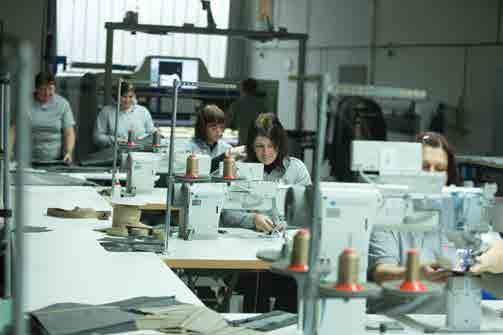
Industry Europe 33 CONSUMER GOODS
New developments in the Consumer Goods
Avantium and Henkel sign offtake agreement on FDCA for adhesives to be used in electronics applications
Henkel and Avantium have been partners

since 2019, when Henkel joined the PEFerence consortium1 . This consortium of partners, coordinated by Avantium, aims to establish an innovative supply chain for FDCA and PEF (polyethylene furanoate). As part of the PEFerence project, Henkel has tested and positively evaluated the feasibility of FDCA for the use of polyurethane adhesives. Now Henkel has decided to proceed and bring those adhesives to the market for the use in electronics applications, such as consumer devices.
For many years, Henkel has been committed to sustainable business practices. As a market leader for adhesives, sealants and functional coatings, Henkel is making an important contribution to climate protection by embracing innovative solutions that facilitate recycling and enable CO2 savings across the
value chain. “Henkel is constantly innovating high-quality and sustainable adhesives to support our customers and ecosystem partners in their implementation of a circular economy. Avantium’s 100% plant-based FDCA enhances our strategy to incorporate renewable carbon into our technology roadmap while offering improved performance in our products. We look forward to continue working with Avantium in the years to come. For us, this is just the start as we see high potential for FDCA in application areas beyond electronics, such as packaging, wood construction or textile lamination”, says Adrian Brandt, Head of Bio-Renewable materials team at Henkel Adhesive Technologies.
Bineke Posthumus, Director Business Development of Avantium Renewable Polymers , comments: “We are very pleased that yet another partner of the PEFerence consortium
has decided to sign an offtake agreement with Avantium. One of the benefits working with such diverse group of reputable companies within the PEFerence consortium is that it enables us to create new applications for FDCA and PEF. The decision of Henkel to use FDCA for polyurethane adhesives for use in electronics applications is a great example of the possibility to use our high-quality, plantbased chemical building block FDCA in various markets and applications.”
Maersk and DP World enter a long-term sustainable partnership
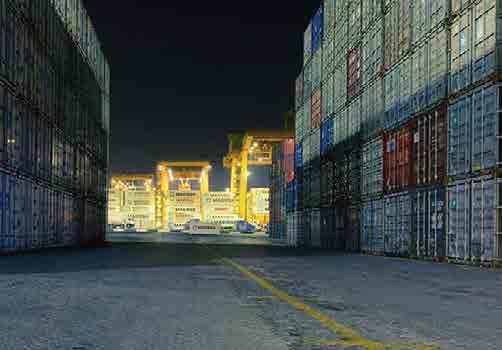
Jebel Ali Port is a leading international gateway port, ideally located to serve the East-West trade corridor connecting to 150 cities globally. Lowering carbon emissions is a common goal for both companies and increasingly demanded by customers, who sit at the heart of every decision the companies take. The Intra Terminal Vehicles (ITVs) at Jebel Ali Port used at the Terminal where Maersk vessels berth will be converted from diesel ones to electric ones leading to a reduction of around 80% carbon footprint from these vehicles alone.
Al Jassmi added, “Additionally, this collaboration will help us to achieve our goal of cutting CO2 emissions by nearly 700,000 tonnes over the next five years. Achieving this target alone will be challenging, but by working with reliable partners such as Maersk we can accelerate our progress and offer solutions to help our partners achieve their own sustainability goals at the same time.”
DDubai: A.P. Moller – Maersk (Maersk) and DP World Jebel Ali Port have entered a long-term partnership through which both parties will collaborate on various aspects of service delivery and work towards a common goal of decarbonising logistics and serve their customers better.
The long-term strategic partnership will give priority berthing for Maersk vessels, support for Maersk’s customers and implement new processes to improve quayside productivity, all leading to faster gate turnaround times at Jebel Ali Port and reduced bunker fuel consumption.
These are alongside visibility tools, which will allow Maersk’s customers to benefit from real-time information relayed by DP World to plan their supply chains better and ultimately cut carbon emissions. Maersk will deploy two of its solutions for customers moving their cargo through Jebel Ali -Maersk Accelerate, a fast-tracking service through priority cargo handling, and Maersk Flex Hub, a cargo storage solution.
In January 2022, DP World entered a strategic partnership with the Mærsk Mc-Kinney Møller Center for Zero Carbon Shipping, an independent, not-for-profit organization launched in 2020 to undertake intensive research and development to find practical ways to decarbonise the global maritime trade industry.
Maersk has the ambition to achieve net zero emissions by 2040 across the entire business with new technologies, new vessels, and green fuels. DP World has committed to becoming a carbon-neutral enterprise by 2040 and net zero carbon enterprise by 2050.
DP World Chairman and Group CEO, Sultan Ahmed Bin Sulayem announced plans in November to invest up to $500 million to cut CO2 emissions from its operations by nearly 700,000 tonnes over the next five years. The reduction in carbon emissions represents a 20% cut from 2021 levels, through electrifying assets, investing in renewable power and exploring alternative fuels.
34 Industry Europe
NEWS
EU adopts new rules on use of recycled plastics in food packaging
Trecycled
plastics to be used in food packaging in the EU. The Commission says the new Regulation will contribute to increasing the overall sustainability of the food system and achieving the objectives of its 'Circular Economy Action Plan'.
INDUSTRYNEWS
"To lower our dependency on primary raw materials and build a fully circular economy, we need to boost the market for recycled plastics and significantly reduce plastic waste in the food sector and beyond," said EC vice-president Frans Timmerman.
"Plastics are useful to preserve food, but their use has to be sustainable. Today's new rules enable food manufacturers to use more recycled plastics in food packaging. This is an important step towards safe and sustainable use of recycled plastics in the food sector."
The aim of the new Regulation is to authorise recycling processes for manufacturing safe recycled plastic materials for use in food packaging. It also looks toi help the recycling industry establish suitable ways for recycling plastics that presently cannot be recycled into food packaging.
In addition, the European Food Safety Authority (EFSA) has said it will have a better basis to evaluate the suitability of recycling technologies and the safety of recycled plastic in food packaging manufactured using these technologies.
The Regulation will allow granting individual authorisations for more than 200 mechanical PET (polyethylene terephthalate) recycling processes, which will help the industry to meet the binding 2025 target of 25% recycled plastic in PET beverage bottles.
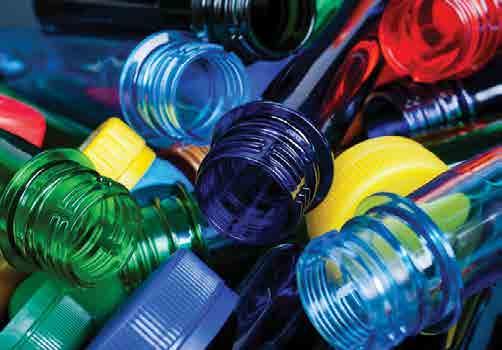
A public register of recycling processes, recyclers, and recycling installations under its scope will also be established, providing an increased level of transparency.
Andrex & Kleenex to be powered by hydrogen in UK

Consumer goods firm Kimberly-Clark, the company behind products such as Andrex, Kleenex and Huggies, has signed an agreement with Carlton Power to supply hydrogen to the company's facility in Barrow-on-Furness in the UK.
Carlton says that the partnership will support the development of its proposed Barrow Green Hydrogen scheme in the northern county of Cumbria, and reduce Kimberly-Clark’s reliance on natural gas as part of its global decarbonisation strategy.
The Barrow Green Hydrogen scheme, the first of its kind in Cumbria, was announced earlier this month. Carlton Power is leading the development in partnership with a regional public/private sector consortium - Cumbria Local Enterprise Partnership, Barrow Borough Council, Cadent Gas and Electricity North-West.
Barrow Green Hydrogen will provide KimberlyClark and potentially other energy-intensive users in the area, such as those with transport fleets, with hydrogen to fuel their operations.
The project will initially feature a 35 MW electrolyser, expected to produce approximately 3500 tonnes of hydrogen every year - reducing 25,000 tonnes of greenhouse gas emissions which is equivalent to taking 580 trucks off UK roads annually. The hydrogen will be produced
by the electrolyser using electricity that is generated from sources of renewable energy, primarily wind and solar power.
Subject to planning and financing, the £40 million (€46.6 million) scheme is targeted to begin commercial operations in 2025.
The Barrow Green Hydrogen project is contingent on securing UK government financial support via its Hydrogen Investment Package (HIP), a multi-million-pound programme to encourage the growth of the hydrogen economy in the UK. The two companies will work together to obtain funding and operational financial support from the Department of Business, Energy & Industrial Strategy (BEIS). A submission to BEIS will be made within the next three months.
They will also work together on the various economic, technical, and engineering aspects of the scheme, as well as consultations with local and national stakeholders.
Kimberly-Clark recently announced plans to decarbonise approximately 80% of its electricity supply through a Power Purchase Agreement, which will lead to the construction of a new onshore wind farm in Scotland that will start operating in early 2023.
Eric Adams, Hydrogen Projects Director at Carlton Power said: “The development of green hydrogen projects like our Barrow hub is critical if major energy users, like Kimberly-Clark, are to decarbonise their operations. At a regional level, our scheme forms part of Cumbria’s Clean Energy Strategy. It’s a catalyst to establish a hydrogen economy and drive the decarbonisation of local industry.”
Dan Howell, Vice President & Managing Director, Kimberly-Clark UK & Ireland said: “Green hydrogen is a significant next step in decarbonising our operations and delivering our ambition of 100% renewable energy by 2030 in the UK and Ireland. Kimberly Clark aims to lead the way on sustainability and deliver our purpose of Better Care for a Better World.”
Visit: www.kimberly-clark.com
Industry Europe 35
NEWS
CONSUMER GOODS
New developments in Energy & Utilities
North Sea Port CO2 capture hub to cut Belgian emissions by 15%

The three partners are pushing ahead to develop a key infrastructure which accommodates the CCUS chain.
Ghent Carbon Hub is already set up as an open-access hub to transport and liquefy CO2 from emitters, provide buffer storage and load the liquefied CO2 onto ships for onward permanent storage. The feasibility study is already underway and commissioning is targeted for completion by 2027.
"Together with our partners, we offer strong and complementary know-how and expertise for providing reliable and efficient decarbonisation solutions, essential for achieving climate change objectives and ensuring the long-term viability of the economy. Ghent Carbon Hub is an integral part of the full-scale Fluxys CO2 approach, offering emitters in North Sea Port and the wider area the opportunity to convey their captured CO2 through our backbone."
Apartnership comprising of Fluxys, ArcelorMittal and North Sea Port has begun a feasibility study for the Ghent Carbon Hub project in Belgium, an open-access CO2 storage and liquefaction hub in the Ghent part of North Sea Port.
Besides carbon-neutral energy, carbon capture, utilisation and storage (CCUS) is increasingly considered to be essential for CO2intensive industries to achieve net-zero emissions, especially in hard-to-abate sectors with processes inherently generating CO2 emissions, such as shipping.
When complete Ghent Carbon Hub will be able to process 6 million tonnes of CO2 per annum (MTPA), equivalent to around 15% of Belgian industrial CO2 emissions.
The project will benefit from Fluxys’ long experience in terminalling activities, while Fluxys is also developing an open-access CO2 transmission backbone in Belgium. Ghent Carbon Hub connects into Fluxys’ CO2 backbone, allowing CO2 emitters from the North Sea Port area and other industrial clusters to transport their captured CO2 to the hub or locations of reuse.
Pascal De Buck, CEO of Fluxys said:
Daan Schalck, CEO of North Sea Port added: "North Sea Port has the ambition to halve CO2 emissions by 2030 and to be a carbon-neutral port by 2050. Total CO2 emissions in the port are 21.5 million tonnes.
"As a first step, the capture and storage of CO2 will have to be increased. Technological developments will be key to the reuse of CO2 over time. The capture and storage of CO2 is a necessary intermediate step towards its large-scale reuse. To this end, North Sea Port is fully engaged to facilitate this CO2 infrastructure project to make it happen."
This MOU will enable the revolutionary new Waste-to-Hydrogen plant at East Port Said to operate producing clean hydrogen while significantly reduce plastic waste, a problem that is global in nature and a topic that is to be discussed at COP27. Between the 1970s and the 1990s, plastic waste generation has more than tripled, reflecting a similar rise in plastic production. Today, we produce about 400 million tonnes of plastic waste every year, and this is forecasted to reach 1,100 million tonnes by 2050. Of the seven billion tonnes of plastic waste generated globally so far, less than 10 percent has been recycled.
GreenPlanet for Sustainable Environmental Solutions., an Egyptian company (S.A.E.) that specializes in the Environmental aspects, with a special emphasis on waste management systems, signed a memorandum of understanding (MOU) with H2-Industries Inc. to provide the necessary feedstock comprising organic and non-recyclable plastic waste for the new Waste-toHydrogen plant at East Port Said/ Suez Canal Economic Zone, Egypt.

Signed by Mohamed Assad, Chairman of Green Plant for Sustainable Environmental Solutions, and Michael Stusch, Executive Chairman and CEO of H2-Industries Inc., the MOU is important as the new Waste-to-Hydrogen plant will need a constant supply of organic and non-recyclable plastic feedstock in order to produce the targeted 300,000 tons of clean hydrogen per year.
In many countries, the infrastructure does not exist or is not sufficiently robust to guarantee waste collection, and therefore supplying a constant supply of feedstock is a challenge. Green Planet has undertaken to provide the necessary feedstock - up to 4 million tons of waste annually and, as such, will be developing a full supply chain in addition to managing a pre-treatment facility. Establishing a robust supply chain will enable the new Waste-to-Hydrogen plant to operate at capacity and, in doing so, will solve two common problems. These are the environmentally friendly disposal of waste, especially plastic waste, and the creation of generation capacity for clean energy in the form of CO2-emission-free hydrogen challenges that many countries face today.
Michael Stusch said, “This is just the first of several international projects where governments and responsible authorities around the globe realize that organic waste and especially plastic waste if treated correctly, can be a valuable asset and used to generate significant amounts of clean hydrogen”.
“The infrastructure that Green Planet will develop, and the feedstock it will provide as part of this landmark project, is truly a technology enabler accelerating energy transition in Egypt while providing an example to the rest of the world,” said Mohamed Assad.
36 Industry Europe NEWS
H2-Industries and Green Planet sign landmark Waste-to-Hydrogen feedstock deal during COP 27
Iberdrola sells 49% of first offshore German wind farm for €700m
With an installed capacity of 350 megawatts (MW) it has been supplying clean energy to approximately 350,000 German households since it was commissioned in 2018.
The transaction further advances Iberdrola`s asset rotation plan to finance new renewable projects under development.
Iberdrola had almost 1,300 MW of offshore wind capacity in operation by the end of June 2022. In addition, it has 3,000 MW under construction, another 4,000 MW secured and an extensive project pipeline under development.
Elsewhere, the group has two offshore wind farms in operation: West of Duddon Sands and East Anglia One commissioned in 2017 and 2020 respectively and located in the UK.

Spanish energy giant Iberdrola has sold off a 49% stake in its first operational stake for €700 million. Iberdrola will remain the majority 51% shareholder. According to the agreement, Wikinger’s total valuation amounts to approximately €1.425 billion. Iberdrola will continue to control and manage the asset, leading the operations and maintenance services.
EIP is a major Swiss infrastructure investment company focused on the global energy transition, with a track record as a long-term shareholder in the industry and experience in infrastructure and renewable technology.
Iberdrola, chaired by Ignacio Galan, is a major global player in offshore wind power. Wikinger is one of the company’s flagship operational projects and was the first offshore wind farm developed by the group on its own.
In the United States, Iberdrola group has begun construction of the country’s first commercial-scale offshore wind farm: Vineyard Wind. Located off the coast of Massachusetts, its 800 MW capacity will meet the energy needs of 1 million homes. In total, Iberdrola has approximately 5,000 MW of offshore wind projects under development in the United States, including Park City Wind with 804 MW and Commonwealth Wind with 1,232 MW.
In Germany, the group has started construction of the 476-MW Baltic Eagle project in the Baltic Sea. Next year, construction will begin on Windanker, which will have a capacity of 308 MW.
These new wind farms will be joined by Saint-Brieuc, in French waters, which is expected to come into operation in 2023. It will have a capacity of 496 MW and will be located off the coast of Brittany, 20 kilometres offshore.
Iberdrola’s global offshore wind pipeline includes a wide range of projects at different stages of development in countries such as the United Kingdom, the United States, Ireland and Sweden, along with an expanding portfolio in countries such as Japan, Taiwan, the Philippines and South Korea.
EU project aims to cut CO2 emissions in refractory sector drastically

issues in regard to Europe’s carbon footprint. And they do so by focusing on the recycling of fire-resistant industrial products.
"Currently we are working on preparing samples of the used fire-resistant material from steel and cement production."
Aresearch
project, funded by the European Union, is targeting the recycling process in the refractory industry. The international initiative, which is part of the Horizon program, could help decrease CO2 emissions in the refractory industry by up to 800,000 tonnes per year.
The eight research partners have taken on the challenge under the lead of global refractory giant RHI Magnesita. With high-end technologies and the combined knowledge from geology, laser technology, and hyperspectral imaging, amongst others - the researchers from five countries are seeking to solve one of the bigger
"On average, 60% of all spent refractories, generated by refractory-consuming industries, go to landfill, while only 30% is recycled. With the ReSoURCE project, we aim to increase it up to 75%. This means we can achieve significant savings of CO2 emissions per annum. With this research project, we have the chance to make a difference in the world," said Stefan Borgas, the CEO of RHI Magnesita.
It is the first time for the company with its 12,000 employees to lead a research project funded by the European Union.
The aim of the ReSoURCE project is to develop a working sensor-based system for refractory waste sorting and powder handling. If successful,
"We are very much aware that we cannot reach our goal without our partners in Austria, Germany, England, Ireland and Norway," said Saranya Azhaarudeen, the project manager who is coordinating the international workflow from RHI Magnesita’s headquarters in Vienna.
The process was designed at the Montanuniversität in Leoben by Karl Friedrich, an expert in waste management and recycling. From Leoben, the prepared samples will be shipped to Germany and Norway, where specialists at the Innolas Laser GmbH and the Norsk Elektro Optik AS will start their first experiments. Other partners in this groundbreaking project for recycling in the refractory industry include LSA GmbH and the Fraunhofer Institute in Germany as well as SINTEF in Norway, CPI in England and Crowdhelix in Ireland.
“I am confident that we will reach our goal in time and am grateful that we were given the financial support that we needed by the European Health and Digital Executive Agency (HaDEA),” added Azhaarudeen.
In order to create the most transparent access, the public can follow the progress of the endeavors up close through a science weblog, that can be found on the project’s website: https://www.project-resource.eu.
Industry Europe 37 NEWS
INDUSTRYNEWS
ENERGY & UTILITIES
New developments in Healthcare
European Medicines Agency green lights Novavax Covid booster
In a separate development, the EMA also gave its backing to two other Covid-19 boosters which are updated to target the Omicron variant.
Developed by Moderna and the Pfizer-BioNTech partnership, these new so-called bivalent shots combat the original virus strain, as well as the BA.1 Omicron strain.
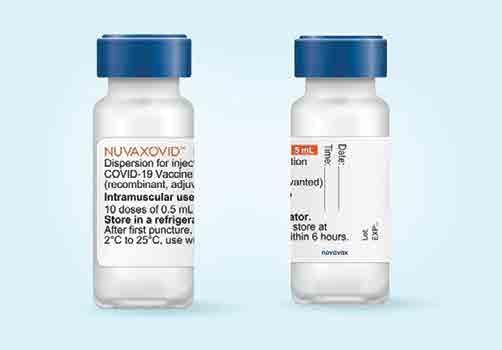
Novavax's Nuvaxovid debuted some time after the first set of Covid shots, including those from Moderna, Pfizer-BioNTech, AstraZeneca and Johnson & Johnson, received approval in different parts of the world.
Nuvaxoid is based on technology that has been used for decades to combat diseases such as influenza and hepatitis B. The hope is that the vaccine will incentivise those people who were sceptical about the newer shots based on mRNA tech to receive a jab.
Tuseof Novavax's Covid-19 shot as a booster for adults, ahead of an expected spike in infections this coming winter.
The vaccine, named Nuvaxovid, targets the original strain of the virus that emerged in Wuhan, China, in late 2019. The EMA recommends the booster for those previously inoculated with any Covid vaccine.
Nonetheless, demand has been weak. Last month the US-based drug maker Novavax cut its annual revenue forecast by half, based on limited demand for its shot as a primary course.
As a booster for people who have previously received other vaccines, it could still offer the potential of a broader spectrum of protection, some experts have suggested.
For more information, visit: /www.ema.europa.eu
Breakthrough med tech could bring "paradigm shift" in Parkinson’s treatment
Sufferers of Parkinson's Disease in the UK could soon benefit from the public funding of a new technology that doctors say could bring a "paradigm shift" in the treatment of the disease.
The National Institute for Health and Care Excellence (NICE) is presently evaluating PDMonitor, a continuous monitoring system for people with Parkinson's created by medical device firm PD Neurotechnology for use in the UK's National Health Service (NHS).
The company will submit information to NICE ahead of its Committee meeting at the end of the month where devices for the remote continuous monitoring of Parkinson's sufferers will be discussed.

The PDMonitor is one of four medical devices currently being evaluated by NICE as part of its Diagnostic Assessment Programme.
PDMonitor uses medical-grade wearable technology to track Parkinson's motor symptoms automatically and on an ongoing basis. It enables physicians to tailor treatment plans based on a stream of objective data showing how patients experience symptoms in their dayto-day lives.
More than 150 physicians have already been trained to use PDMonitor, and the technology is currently used in private or hospital practices by physicians and patients in the UK, France,
Austria, Germany, Italy, Spain, Sweden, Ireland, Greece and Cyprus.
Preliminary feedback from Parkinson's sufferers that have monitored their symptoms for up to two years with PDMonitor indicates that 43% felt their condition had stabilised and 35% said to had improved after starting to use the technology. Clinical trials in Germany, Italy and Greece have already recorded very high reliability and specificity levels, and symptom detection accuracy of up to 93%.
Professor Ray Chaudhuri, Head of Parkinson's Research at King's College Hospital, who has been piloting PDMonitor with private patients since March 2022, said: "Parkinson’s is the world’s second most common neurodegenerative disease and a significant cause of disability. Patients’ quality of life and disease progression strongly depend on the consistent, prompt staging of the disease and optimal timing and dosing of the prescribed therapy."
"PDMonitor is supporting a paradigm shift in Parkinson’s care by improving the quality and timeliness of information physicians have to assess the disease. Monitoring patients at home, continuously while they conduct everyday activities, allows treatment decisions to be made more frequently and physicians to respond faster to changing symptoms.
"While you cannot reverse Parkinson’s, you can delay the deterioration of symptoms and possibly decrease the risk of falling. Optimising care means the disease progresses slower in time and the therapeutic window is kept open."
Nikos Moschos, founder of PD Neurotechnology, added: "Today, most Parkinson’s treatment is informed by subjective patient diaries reviewed by physicians once or twice a year. We’ve changed the game by providing physicians with a stream of objective data showing disease progression in the real world.
"Our transformative, medical-grade technology offers continuous monitoring, full symptom coverage and a holistic view of the patient. The majority of patients feel their health and quality of life stabilised or improved after using PDMonitor. This is data and AI at its finest."
38 Industry Europe NEWS
Parkinson's treatment. Credit: PD Neurotechnology
BASF and MedAccess complete shipment of 35 million Interceptor® G2 nets to fight malaria
BASF
and MedAccess today announced the achievement of their goal to supply 35 million Interceptor® G2 mosquito nets to 16 countries in sub-Saharan Africa by the end of 2022. The agreement to supply the mosquito nets is part of a financing partnership involving both companies and the Bill & Melinda Gates Foundation.
In October 2019, the partners launched a volume guarantee with the goal of distributing 35 million nets, supporting the work of malaria partners including the New Nets Project, which is funded by The Global Fund and Unitaid, and implemented by the Innovative Vector Control Consortium (IVCC). This target has been reached ahead of schedule, meaning that 63 million people are now being protected by Interceptor® G2 nets, with wider benefits that include more children accessing education[1].
Malaria remains one of the leading causes of mortality. According to the World Health Organization (WHO) 2022 World Malaria Report, there were 247 million cases and approximately 619,000 deaths from malaria globally. Children under five are especially vulnerable and nowhere is the problem more severe than in Sub-Saharan Africa[2].
Long-lasting insecticide-treated mosquito nets play a vital role in protecting people from malaria, contributing to falling cases in the past two decades. However, mosquitoes have developed resistance to the active ingredient,

since the 1980s. As a result, since 2017, the number of cases started to rise again.
“With the achievement of this milestone, millions more people now have access to a powerful new malaria prevention tool that can help drive down cases in areas with insecticide resistance,” said Trevor Mundel, President of Global Health at the Bill & Melinda Gates Foundation. “We’re proud to be part of this agreement with BASF and MedAccess which was able to deliver on its ambitious goal, demonstrating the ability of innovative partnerships to deploy critical solutions in the fight against malaria.”
The volume guarantee enabled BASF to provide its Interceptor® G2 to the New Nets Project at a 40% price reduction and tens of millions of people to benefit from the nets while studies showed its effectiveness in settings with high insecticide resistance.
Michael Heinz, Member of the Board of Executive Directors at BASF, says: “We have reached remarkable achievements in the fight against
mosquito-borne diseases such as malaria. But as long as this disease exists, it threatens the poorest and most vulnerable populations – and it has the potential to resurge in times of crisis, like during pandemics. That is why we work tirelessly to completely eradicate it.”
A study published in the medical journal The Lancet confirms that Interceptor® G2 nets bring additional public health value compared to conventional nets. The results in Tanzania show that over the period of two years, Interceptor® G2 reduces malaria incidence by 44% and the number of captured malaria-infected mosquitoes by 85% compared to standard nets[3].
Fatima Bukar Ali, Assistant Chief Scientific Officer at Nigeria National Malaria Elimination Programme, comments on how the new nets have been received by local communities: “Entomological and vector surveillance studies found mosquitoes in our area with resistances to standard nets, for that reason we introduced Interceptor® G2 nets to our communities. The acceptance has been high. With the latest studies confirming that the new nets are more effective than conventional mosquito nets, we expect even greater demand in the future.”
To successfully continue the fight against malaria, BASF has already begun the development of a third generation of nets.
EU & Spain's HIPRA sign joint procurement deal for Covid vaccines

"We need to ensure maximum preparedness as we head into the autumn and winter months. The HIPRA vaccine adds yet another option to complement our broad vaccine portfolio for our member states and citizens," said Commissioner for Health and Food Safety, Stella Kyriakides.
"An increase in vaccination and boosting is essential over the coming months. We are working tirelessly to make sure there are vaccines available for all," she added.
The HIPRA bivalent recombinant protein vaccine was developed as a booster shot for previously immunised people 16 years and older. Similarly to the vaccine developed by US-based pharma company Novavax, the HIPRA jab uses a recombinant protein.
TheEuropean Commission has signed a joint procurement contract with Spanish pharmaceutical company HIPRA for supplying its protein Covid-19 vaccine, which is currently awaiting approval by the European Medicines Agency (EMA).
The EU executive body said that 14 member states would take part in the joint procurement, under which as many as 250 million doses can be purchased.
Cases of Covid-19 are rising again in Europe, and the agreement aims to make HIPRA's vaccine quickly available to the participating countries.
It also needs to be stored at a refrigerated temperature between 2 and 8ºC, making storage and distribution in Europe and across the world easier.
In December, a HIPRA executive told Reuters that the company was confident that its experiment Covid-19 vaccine would be in high demand in the EU, as it is designed to offer protection against new variants of the virus, can be stored and transported easily, and can be mass-produced.
The Spanish company specialised in veterinary vaccines for some 50 years and is active in over 100 countries. It has already signed a purchase deal with Vietnam, where it conducted tests, for the supply of 50 million doses.
Industry Europe 39
NEWS
INDUSTRYNEWS
HEALTHCARE
New developments in Metals & Mining
Epiroc wins large equipment order for platinum mine in South Africa
Stockholm,
Sweden: Epiroc, a leading productivity and sustainability partner for the mining and infrastructure industries, has won a large order for low-profiling mining equipment from African Rainbow Minerals for use at a platinum mine in South Africa.
African Rainbow Minerals has ordered drill rigs, loaders and mine trucks for use at the Bokoni Platinum Mine in the Limpopo Province, South Africa. The mine is restarting after operations have been paused for care and maintenance the past few years.
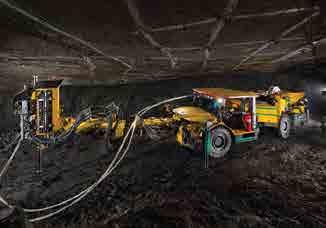
The order is valued at more than MZAR 200 (MSEK 125) and was booked in the first quarter 2023.
“We are excited to once again provide equipment to the Bokoni Platinum Mine,” says Helena Hedblom, Epiroc’s President and CEO. “We look forward to supporting African Rainbow Minerals as they restart and operate the mine in the most productive and safe way possible.”
The machines ordered are built with a low profile well suited for the mine’s low tunnel heights. The equipment includes Boomer facedrilling rigs, Boltec and Cabletec rock-reinforcement rigs, Scooptram loaders and Minetruck haulers. All machines come with Epiroc’s Certiq telematics solution for automated monitoring of productivity and machine performance. Other advanced features include, for example, the
Boomer machines being equipped with a pilot hydraulic control system that further improves drilling accuracy.
Delivery of the equipment will begin during the first quarter 2023 and will continue into 2024.
SLM Solutions and Danish Technological Institute Collaborate to Revolutionize Metal Additive Manufacturing
Today, SLM Solutions, the leading metal additive manufacturing technology provider, announced a game-changing collaboration with the Danish Technological Institute (DTI) to scale up the industrialization of additive manufacturing. This partnership is set to revolutionize the metal additive manufacturing industry by developing new outstanding parameters for SLM® machines and the NXG XII 600.
With their recently acquired SLM®280 2.0, DTI is developing faster process parameters for stainless steel 316L and copper alloy CuCr1Zr to support cost-effective production, taking advantage of SLM Solutions' importance of open architecture. The material development collaboration will create new application opportunities for advanced components, where electrical and thermal conductivity are crucial, and sturdy components out of stainless steel can be manufactured with lightning-fast processes.
The partnership between DTI and SLM Solutions is the natural next step in their long-term relationship. “The collaboration with SLM Solutions is extremely interesting for us. With SLM Solutions' expertise in special alloys for additive manufacturing, this collaboration gives us a unique insight into future possibilities,” says Ellen M. J. Hedegaard, Business Manager at DTI.
The development allows the copper alloy CuCr1Zr to be printed in varying layer thicknesses and creates new business cases where AM will be used for advanced components where electrical and thermal conductivity are important. With up to 92 % IACS after heat-treatment, CuCr1Zr still features very high electrical conductivities at up to 300 MPa ultimate tensile strength. SLM Solutions' stainless steel 316L, on the other hand, is an austenitic high-chromium steel with excellent processability on SLM Solutions' additive manufacturing machines. 316L is often used in applications requiring good mechanical properties and excellent corrosion resistance, especially in chloride environments. DTI will develop faster process parameters for stainless steel 316L, enabling the possibilities of printing components at a lower price.
With this ground-breaking partnership between SLM Solutions and DTI, further industrialization and increased use of metal-based additive manufacturing will take a significant leap forward. Industry will get a front-row seat to witness the future of additive manufacturing.
About Danish Technological Institute
The Danish Technological Institute - DTI - is a leading research and technology institute employing more than 1,000 specialists that help over 10,000 customers from 65 different countries each year. DTI prides itself on being a multi-disciplinary institute where challenges are approached in an innovative manner, tapping into their various specialties to find the bestsuited solution. The Institute is structured into five divisions of expertise; Materials, food & production, environmental technology, energy & climate, and building & construction.
In the DTI Center for Industrial 3D printing, more than 30 years of experience with additive manufacturing is available, from small series production to the use of AM as an integrated part of the production chain. The modern facilities in Aarhus offers 3D-printed components in a range of metal and polymer materials, utilizing a wide variety of additive manufacturing technologies to tailor a solution that perfectly fits the customers‘ needs.Further information is available on www.dti.dk/3dprinting
About SLM Solutions
SLM Solutions is a global provider of integrated metal additive manufacturing solutions. Leading the industry since its inception, it continues to drive the future of metal AM in every major industry with its customers’ long-term success at its core. SLM Solutions is home to the world’s fastest metal additive manufacturing machines boasting up to 12 lasers and enabling build rates of up to 1000ccm/h. With a portfolio of systems to suit every customer's needs, along with its team of experts closely collaborating at every stage of the process, SLM Solutions leads the way in return on investment with maximum efficiency, productivity, and profitability. SLM Solutions believes that additive manufacturing is the future of manufacturing and has the desire and capability to take its customers there – right now.
SLM Solutions is a publicly-traded Company headquartered in Germany, with offices in Canada, China, France, India, Italy, Japan, Singapore, South Korea, and the United States.Further information is available on www.slm-solutions.com
40 Industry Europe NEWS
Metso Outotec introduces scalable Thickening Plant Units for paramount circuit performance
Metso
Outotec is introducing scalable Thickening Plant Units to ensure outstanding circuit performance and reliability for any minerals processing application or capacity.
Comprising High-Rate Thickeners, High-Compression Thickeners, Paste Thickeners, Clarifiers and Polymer Dosing Units, the Metso Outotec Thickening Plant Units fit seamlessly with other dewatering units, like filtration or any type of water treatment applications. The pre-engineered units incorporate Planet Positive ReactorwellTM feedwell technology, maximizing thickener performance while minimizing flocculant consumption.
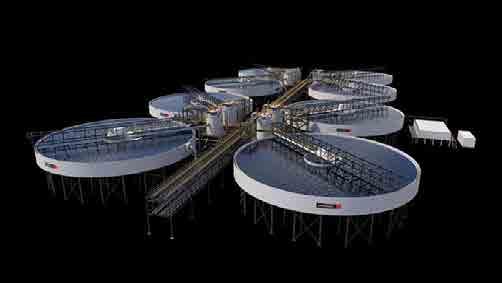
“Decreasing ore grades sets new challenges for the mining industry. Equipment design needs to integrate seamlessly across the process to avoid underperformance and recovery losses. Our new Thickening Plant Units feature scalable, modular components, and the integrated units deliver consistent performance even in changing process conditions. What’s more, the productized and partially modular units are quick and safe to install and commission,” explains Toni Kuisma, Product Manager for Dewatering Islands at Metso Outotec.
Metso Outotec Thickening Plant Units offer unique benefits:
• A wide and proven range of proprietary equipment with innate digitalization for the whole plant, providing consistent performance in changing process conditions
• Industry-leading ReactorwellTM feedwell technology to ensure efficient use of the clarification area
• Better risk management through process performance guarantees
• In-house testing and sizing
• Expert support in the design of individual applications, based on extensive plant design know-how and numerous references for various applications, concentrate and tailings
Metso Outotec has one of the widest portfolios of thickening solutions on the market. The company’s extensive experience in process plant design combined with an installed base of around 3,000 thickener equipment installations around the world enables Metso Outotec to design and deliver complete optimized thickening plants catering to all types of applications and ores. The company’s comprehensive service portfolio extends from spares and wears to advanced life cycle services and is backed by a global network of industry-leading service expertise. The wide variety of upgrades enables the restoration of outdated existing technology for optimized thickener performance and the achievement of sustainability targets.
The Thickening Plant Units are Metso Outotec’s fifth complete plant unit launch for concentrator plants. The previous launches include Stirred Mill Plant Units, Horizontal Mill Plant Units, Filtration Plant Units, and Flotation Plant Units.
Metso Outotec expands filter production in China to respond to growing demand
Metso
Outotec will expand its filter assembly plant in Suzhou, China, to respond to global market demand. The plant expansion will not only double local capacity in China to deliver high-quality filters for mining and other industrial customers, it will also provide additional space for the assembly of flotation drive mechanisms and mill reline equipment.

The extended production facility is expected to open within a year and reach full capacity during H1 in 2024. With the expansion, the number of personnel working at the plant is anticipated to increase to around 60 experts.
“Filters are used in mining and industrial applications to separate solids from liquids. In Suzhou, we produce several of the different filter types we offer in our global portfolio. Originally, filter assembly in Suzhou began in 2009, and it has been operating at the same location ever since,” explains Tero Tiainen, Director, Filter Manufacturing at Metso Outotec.
“In connection with the expansion, we will also update our procedures for simplified processing,
modular manufacturing and lean management to enable fast deliveries to our customers. This, combined with our established engineering, sourcing and production expertise in Suzhou will provide our customers with enhanced service and product quality,” says Chuncai Qiu, Suzhou Plant Manager.
different filter types and comprehensive services for hundreds of applications. Over 80% of the Metso
Outotec filters are part of the company’s Planet Positive portfolio, mainly because of their efficiency in the recovery and reuse of water. The company has carried out more than 14,000 filtration tests and delivered more than 5,000 filters for various applications worldwide. Most of the filters are sold
Industry Europe 41
NEWS
INDUSTRYNEWS
METALS & MINING
New developments in Politics & Economics
Manufacturing M&A In UK Reached Six Year High In 2022
Mergers and acquisitions (M&A) activity in 2022 involving UK based manufacturers was at its highest level since 2016, according to law firm Irwin Mitchell.
Irwin Mitchell has analysed Experian’s Market IQ database and revealed that 1,344 UK manufacturing businesses were the target of M&A activity in 2022. This compares to 1,285 in 2021 and 1,231 in 2020.
According to Irwin Mitchell, deal volumes in the sector in 2022 were at the second highest level in the last 10 years with activity levels last year beaten only by 2016 when 1,537 deals were completed.
In 2022, most transactions (57%) were acquisitions whilst management buyouts (MBOs) accounting for 4% of deals. Only 1% of deals were restructuring transactions compared to 9% in the previous year.
According to Irwin Mitchell, overseas bidders continue to have a big impact on UK M&A in the manufacturing sector. Last year 30% of deals
with a UK-based target business involved an overseas bidder. Eight percent of these bidders were based in the US with Sweden accounting for 3.5% of deals. Germany and France both accounted for 2.3% of activity.
London and south-east based manufacturing businesses generated 316 transactions in total and this was the busiest area in the UK for deals in the sector. Over a third of deals (36%) in the capital where VC backed compared to the national figure of 22%. In the north-west, just 12% of manufacturing deals were backed by venture capital, while in Yorkshire the figure was much higher at 27%.
Emma Callow, corporate partner at Irwin Mitchell and manufacturing sector expert, said:
“This latest analysis may look surprising bearing in mind the challenges faced by economy last year and although activity dipped in the last quarter of 2022, these figures certainly reflect how resilient the manufacturing sector is.
“It’s clear that UK manufacturers are highly attractive to overseas buyers and also venture capital. At Irwin Mitchell we have recently advised a US PE client in the sector on an acquisition in the UK as well a South African listed company on a substantial UK acquisition, so the statistics are borne out by what we are seeing in practice.
“We have seen deal flow in the sector continue to be strong and early signs show that activity in 2023 may be even stronger than 2022.”
Irwin Mitchell’s corporate team has strong credentials in the manufacturing sector. Last year it advised Motus Holdings (UK) Limited on its £182m acquisition of UK-based automotive components supplier, Motor Parts Direct (Holdings) Limited. It also helped waste management group Reconomy complete its acquisition of leading recycling firm Casepak and sister company, Oceala. The team has also advised private equity firm Acorn Growth Companies on its investment in full-service aftermarket supplier of rotable parts for commercial aircraft, Aerospares 2000.
Walmart-backed scheme to tackle youth incarceration gets 2 new recruits
TheUnlock Potential scheme that counts companies such as Ben & Jerry's and Walmart among its members has welcomed two new companies into the fold in a bid to provide jobs for vulnerable youngsters and keep them out of jail.
Both American Family Insurance and Delta Airlines have announced their participation in the programme, which was founded by the Responsible Business Institute for Justice (RBIJ), which will see them adopt hiring policies designed to create meaningful career opportunities for young adults.
The consultation phase for the scheme end in October, after which all companies involved will begin a 12-month pilot where these young adults will be provided with career placements.
The RBIJ stresses successful candidates will be given significant opportunities for upward mobility within these companies as it seeks to inspire "the next generation of corporate leaders".
The announcement comes just days before millions in the US celebrate Juneteenth. This federal holiday commemorates the freeing of enslaved African-Americans following the end of the Civil War in 1865 and celebrates black culture.
At Industry Europe, we previously covered Ben & Jerry's entrance into the scheme, a company with a history of supporting civil rights.
“By widening the positive life choices available to the young adults who are most at-risk, we can tackle crime, imprisonment, inequality and poverty".
Every day, tens of thousands of people under 18 are jailed in the US. Numbers are decreasing every year, but it still remains a massive issue.
Meaningful employment could be critical in stopping youngsters with no other options for committing crimes. Poverty is among the leading causes of crime.
Due to the nature of having a criminal record, first-time incarceration could decrease lifetime earnings by more than 30%, according to one
report. Unfortunately, black people are five times more likely to end up in prison than whites, owing to several factors, including discrimination in the justice system, and the effects of having a criminal record are apparently more damaging to black people, according to another report.
Many, but not all, American states expunge criminal records once people hit 18 in a bid to give them a second chance.
For now, the RBIJ's scheme will focus on a subset of youth who have experienced one or more of the following additional risk factors for justice system development:
• those with a parent already in prison
• victims of sex or human trafficking
• those involved in the juvenile justice system
• those in foster care
4.4 million Americans between the ages of 16-24 have been identified as "opportunity youth", which means they are currently not in any formal employment or education and are more likely to suffer negative outcomes like poverty or incarceration. In some areas, black and Latino youngsters are 4-6 times more likely to be in this category than their white peers.
This is over 1% of the population of the entire US. For reference, the prison population as of 2022 is estimated to be around 2.1 million - more than 20% of the world's total prison population.
“We know that having a diverse workforce builds a better and more innovative business,” said Keyra Lynn Johnson, Delta’s VP and Chief Diversity Officer. “This partnership builds a bridge to individuals who often don’t have connection and opportunities to careers at Delta, while at the same time broadening our access to untapped talent".
42 Industry Europe NEWS
Russia suspends Japanese fishing rights citing deal payment issues
Russia
has suspended an agreement that gave Japan permission to fish near disputed Southern Kuril islands after accusing the nation of failing to make deal payments.
In a statement, the Russian foreign ministry said: “In the current situation, we are forced to suspend the implementation of the 1998 Agreement until the Japanese side fulfils all its financial obligations".
The dispute between the two countries has been ongoing since the end of World War Two when the islands – which are called the Northern Territories by Japan and the Kurils by Russia – were first seized from Japan.
The fishing deal was made in 1998 and allows Japanese boats to fish around the disputed islands. The sea is a hot spot for octopus, pollack and mackerel. Prior to the deal, Japanese boats were sometimes shot at or captured by Russia.
In May, Japan announced further economic sanctions against Russia, which included banning exports of certain cutting-edge technologies that were set to be delivered to some Russian scientific research institutions. This week, Japan and NATO also stepped up further military collaboration.
Russia’s decision to relinquish the fishing rights is seen by some as a response to Japan’s sanctions.
However, on Wednesday Hirokazu Matsuno, Japan's Chief Cabinet Secretary criticized Russia’s decision but cited Japanese development funding of projects on Sakhalin – a large Russian island that sits just north of Japan – as the reason Russia had withdrawn the fishing rights.
He said it was “regrettable that Russia onesidedly announced it is suspending the cooperation in this manner” but admitted that Japan had not made its latest payment for the project.
“We will do our utmost to protect the safety of the Japanese fishing operation", Matsuno added.
On Sakhalin, there are ongoing oil and gas projects in which the Japanese government and Japanese companies have stakes. In a statement in March Japan said that the projects were important for its energy security.
At the time, Shell and Exxon Mobil said they would be exiting some of the Sakhalin projects as part of sanctions against Russia in the wake of its invasion of Ukraine.
The 1998 deal is just one of four fishing industry related deals between the two nations that concern the disputed waters. The second and third were negotiated this year and covered rights over salmon and seaweed. The fourth is set to be made in December and will decide upon fishing quotas.
Sky-high inflation causes 2023 hangover, stifling tech advances for over a third of manufacturers
WithUK recession concerns front of mind and inflation still tipping ten per cent1, a new study of UK business has found that more than one in three manufacturers (37 per cent)2 are now struggling to fund vital digitisation projects for their sales and marketing functions within previously set budgets. The results reflect how spiralling business costs across the board are impacting companies’ abilities to fully adopt digital sales advances, at a time when the shift to online purchasing is increasing exponentially, so stifling their business growth and keeping them behind tech-savvy competitors.
50 per cent of manufacturers being left behind cited ongoing pandemic disruptions as an additional barrier to progressing any digitisation projects, as well as lack of time (37 per cent). This highlights the stark recruitment challenges companies are facing currently as the number of vacant jobs in the UK reached a record high in 2022 of 1.3 million1. When combined with the boom of ‘quiet quitting’, firms are struggling to work at full capacity and this is impacting their uptake of new developments, and projects are being restricted.
12 per cent of manufacturers said rising energy costs were hindering their progress towards digitisation - a key issue facing many as the UK economy struggles with the cost-of-doing business - meaning revenue is being diverted away from vital sales and marketing projects.
Existing sales processes within the manufacturing sector can often be outdated, with lots of manual administrative processes and laborious exercises increasing the time taken and risk of human error. Digitisation takes these physical, outdated processes and converts them into efficient and effective digital systems. It is proven to support business growth and positive change, with adopters benefiting from improved productivity and efficiency, as well as increased sales and customer engagement.
70 per cent of B2B organisations have invested in digital commerce channels this year, with 73 per cent investing in websites, 49 per cent in sales representatives and 37 per cent in mobile apps2.
The independent research, with a nationally representative sample of 500 business leaders, was conducted by Censuswide on behalf of Software as a Service (SaaS) firm, Adventoris.
CEO of Adventoris, James Clarkson, said: “As 2023 gets underway, these findings lay bare the impact the current economic climate is having on firms in the manufacturing industry and it is disheartening to see the toll inflation and rising energy costs are taking. So many businesses are being held back from reaching their true potential through being unable to progress with plans to adopt digital processes.
“Manufacturers are at the core of British industry and play a huge part in our nation’s economy. Digital processes are having an incredibly positive impact on improving efficiency, productivity and results, but it is obvious from our findings that firms need support to be able to access these benefits.
“Quarter one is going to be tough for many, but digitising sales and marketing functions can bring great advantages. For example, our clients have experienced basket sales increasing by 15 per cent when using our digital sales app technology with their customers.”
Ben Bowen, sales forecast analyst from Staedtler, a firm which has recently adopted digitisation in the form of a sales app, said: “Investing in digitising our sales process has been a brilliant choice for us. The pandemic disrupted so much for our industry with supply chains, usual operating processes and sales routes all interrupted.
“Being able to adopt these digital sales processes has allowed us to futureproof our operation and ensure a smooth, consistent and effective method for our customers.”
Adventoris is the creator of SwiftCloud, a leading B2B mobile app for distributors and wholesalers that provides businesses with a platform that enables their customers to see products, communicate with the company and make orders 24/7. SwiftCloud can save customers over 50 per cent in ordering time.
Industry Europe 43 NEWS INDUSTRYNEWS
POLITICS & ECONOMICS
FASTENERS OF THE HIGHEST QUALITY

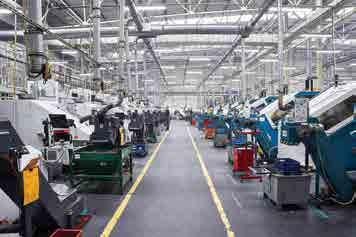
Solvera Gaweł Technology S.A., a company from Łąka, Poland, is the European leading manufacturer of fasteners. In 2023 it celebrates the 40th anniversary of its business operation.
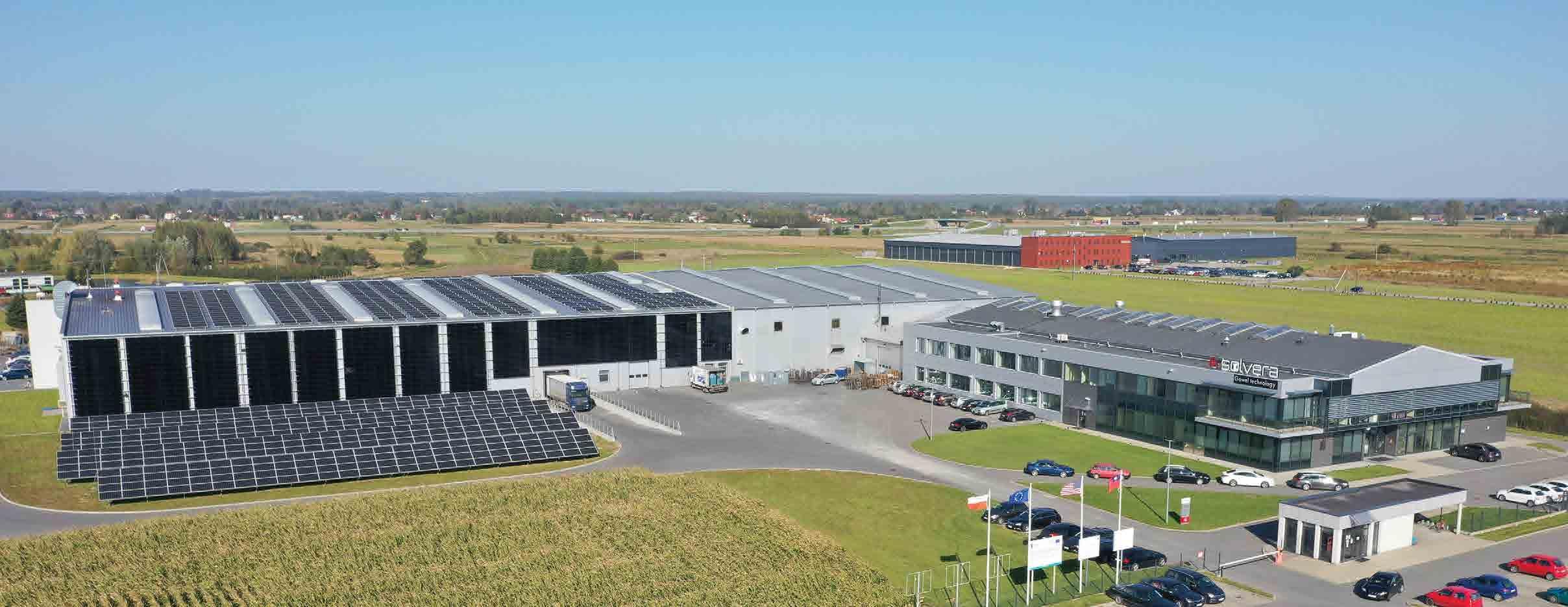

The key area of the Solvera Gawel Technology S.A. competence is the technologically advanced production of fasteners such as screws for wood, metal and plastic. The company has specialized in this field, offering the high quality fasteners delivered for many international corporations from the home appliance, electronic, construction, automotive, and furniture industries. Filling individual and custom-made orders is its priority. Solvera Gawel Technology is a family-run company with entirely Polish capital. It is located in Łąka, a small village near Rzeszow, in south-eastern Poland.
History of the success
The company was founded in 1983 under the name of Gawel Zaklad Produkcji Srub (Gawel Screw Factory). Initially, it focused on metal fabrication for the construction industry. In 1991 it started the manufacture of fasteners. Since then, they have become the company’s main specialization.
Over the following years, the company has constantly expanded its offer with new products, thus gradually becoming the industry leader. Due to its dynamic development, in 1996 it changed the profile of manufactured products from standard to special ones, made according to individual requirements and documentation.
As a consequence of the growing number of orders, in 2004 it opened a new warehouse and office complex, which significantly increased its storage capacity. In 2011 the company gained its first patent for a special thread for plastics - AlfaTech.

Next year the company opened its Research and Development Centre, and two years later a Research Laboratory was
established. Over the time, the Laboratory has evolved into an independent department, which would conduct various types of scientific work, where strength and metallography, as well as mechanical and plastic parameters and assembly of products, would be tested. Corrosion resistance measurements are also within a range of activities carried out in the Lab. Two years later the R&D Centre obtained ISO 17025 certification.
In 2018 the company changed its name to Solvera Gawel Technology S.A. The very same year, it opened Solvera International Inc. in the USA and obtained the IATF 16949 Certification, which replaced ISO/TS 16949 in the automotive industry.
Current market position
Flexibility, the ability to adapt to the market needs, changing trends and requirements allowed Solvera Gawel Technology S.A for continuous and dynamic development. As one of the leading fasteners manufacturers in Europe, it successfully competes with the big global players in the industry. The company’s products are sought after around the world. The half of its sales goes to foreign markets, inter alia, to the EU countries, including Germany, France, and Hungary.
Solvera Gawel Technology S.A owns the company and distribution centre in the United States, which supplies American and Mexican markets. It is also present in the China, and Brazilia.
The company employs 245 people; its annual sales are estimated as PLN 150 million (approx. EUR 32.6 million) in 2021 and PLN 180 million (approx. EUR 38.3 million) in 2022.
Industry Europe 45
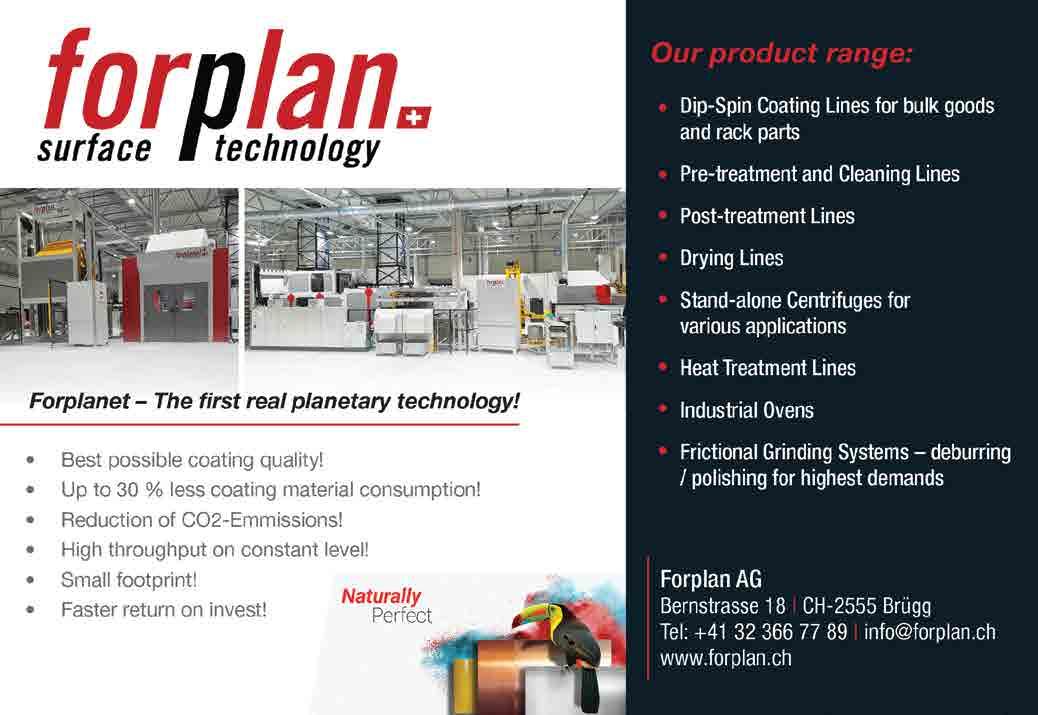
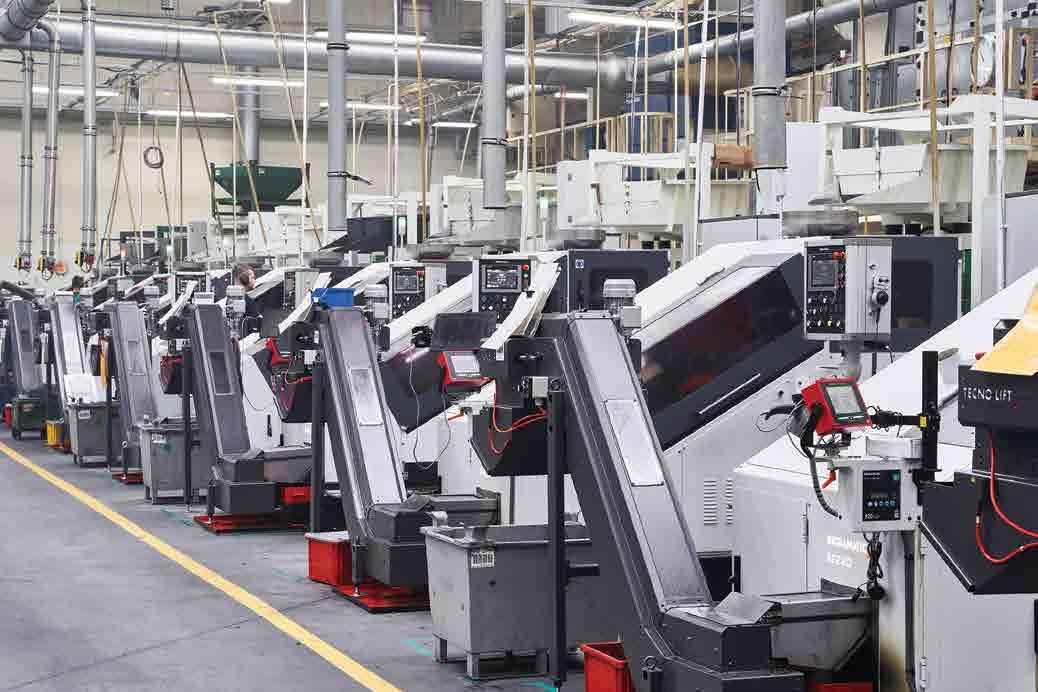
46 Industry Europe

2022 was exceptional year for Solvera Gawel Technology S.A. The company has completed several large investments, which greatly increased the capacity and efficiency of the production processes. It purchased 37 production machines (pressing and rolling mills), another hardening furnace, 10 optical selection machines, a Forplan coating line and an automatic warehouse for storing and transporting semi-finished products between successive production processes. In total, its production capacity increased by almost 50 per cent.
The scope of production
Monthly output of Solvera Gawel Technology S.A reaches more than 250 million products. The range of offered products includes bolts and screws for metal, plastic and wood screws, self-drilling and thread-forming screws, rivets and pins; their diameters vary
steels, and copper and aluminium alloys. It has 73 modern presses including 20 multi-operational machines, from the most renowned manufacturers, as well as 61 high-class rolling mills, allowing for the production of screw threads of different shapes.
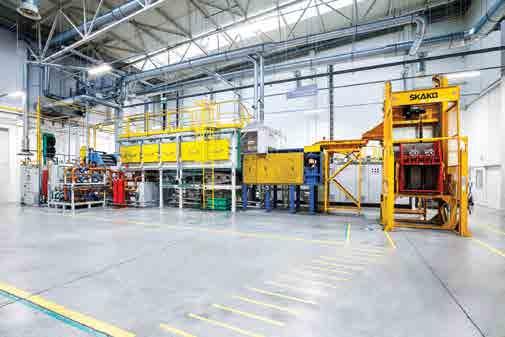
The production process consists of several important stages. Pressing and rolling give the final shape of the products and are followed by the heat treatment that gives the appropriate mechanical properties, then by the application of anti-corrosion coatings, by the 100 per cent optical selection and by packaging.
To ensure the highest quality, repeatability and security of supply, the company buys raw materials only from the best and proven suppliers in Europe, with whom it has long-term cooperation. It also cooperates closely with such big names amongst the machine manufacturers as Carlo Salvi (the leading producer of header machines) or SecoWarwick (the producer of industrial furnaces).
The company also owns fully automatic SecoWarwick heat treatment line, equipped with an automatically modified protective atmosphere and temperature control system. Products manufactured in the company are subjected to toughening or carbonitriding and then tempering to obtain certain mechanical properties.
The production capacity of the line is more than 800 kg of materials per hour.
The corrosion-resistant coatings are based on Dörken’s license. Automatic Forplan’s line ensures stability and repeatability of the coating application process guaranteeing the highest quality of the products. The

48 Industry Europe
ments of customers regarding the types of packaging and labelling. Solvera Gawel Technology S.A. has all the necessary certificates and confirmation of compliance with the production standards, including: IATF 16949:2016, ISO 9001:2015, ISO 14001:2015, ISO 45001:2018.

Looking to the future
The company’s plan for the upcoming years is to continue further dynamic development, further investments in modern equipment


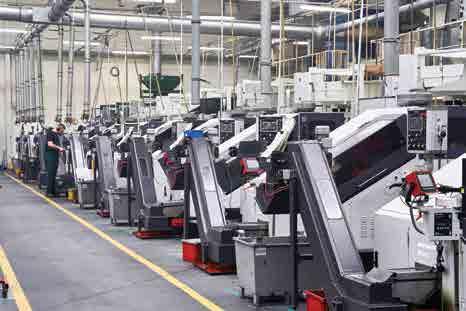
S.A. has the ambition to become a major global player, mainly through further development of the sales network in North American markets. n
For information, visit: https://solvera.pl
Industry Europe 49
New developments in Technology & Innovation
person, which enables truly individual treatment for each and every patient.
6G could accelerate this type of care, and it can be applied to many instances. For example, wearable devices could be used to monitor the vital parameters for both the healthy and the sick. 6G could allow in-body devices to communicate with wearables outside, which in turn can securely transport the data to the healthcare providers as needed.
A more sustainable world
Finally, 6G has the potential to accelerate our transition to net zero. This technology can take us to a greener world in several ways; the starting point is by making the network itself more sustainable.
Ocanuse mobile phones to join a meeting thou sands of miles away at the touch of a button. So when the industry sets out to invent the next generation of mobile connectivity, we must not only address the emerging needs that current technology might not meet but also envision entirely new opportunities, services and industries. More importantly, we must envision how we’ll make this technology a real force for good in the world.
However, we cannot achieve this alone. Collaboration will be instrumental, and companies are keen to play their parts. One of the ways Intel is doing this is through participation in the EU 6G flagship research project Hexa-X — a broad, collaborative initiative to frame the 6G research agenda. Funded by the European Commission, this project will set the stage to make 6G a reality by 2030.
With 6G, we can expect to see the convergence of communications, computing and artificial intelligence (AI). Critically Intel’s technology will allow for computing and AI to be natively integrated into the 6G system instead of just running as an application on top of network infrastructure. Users will be able to access almost infinite compute power and AI/ML resources through Intel’s Compute-as-a-Service (CaaS) and AI-as-a-Service (AIaaS) interfaces.

A healthier world
Ageing populations, increasing risk of extreme weather injuries and the potential for further pandemics are making remote and accessible healthcare more vital than ever.
Today, medicine typically follows a onesize-fits-all approach to disease treatment and prevention strategies. In contrast, precision healthcare considers the individual variability in the genes, environment and lifestyle of each
Wearable, remote technology also could help those with vision impairments to navigate the world. For example, wearables equipped with sensors could be leveraged to infer and identify objects, street furniture and other possible hazards so that users can navigate their surroundings independently.
Finally, the convergence of communications, computing and AI has the potential to support processing images and diagnosing patients. For example, AI that follows the artificial intelligence as a service (AIaaS) concept could process a picture of a patient’s skin and instantly identify whether there is a suspicious pattern relating to skin cancer. While this wouldn’t replace doctors, it certainly could create new efficiencies.
A more collaborative world
With the potential to achieve speeds over 1,000 times faster than 5G networks, this new near-instant wireless technology can take digital collaboration to new heights.
Through 6G-enabled mixed reality and holographic telepresence, silos could be shattered across remote office locations, teleconsultations and educational e-learning environments. The interactions of tomorrow could even include haptic connections — communication involving touch as well as sight and sound.
Admittedly, such telepresence meetings would require tremendous data bandwidth. They also would need considerable compute and AI power to record, transmit and reconstruct corresponding holographic images of colleagues. But meetings that were once confined to sci-fi films could become the reality of every office.
Underpinned by 6G, these digital replicas could allow us to perfectly optimise traffic flow, build houses capable of withstanding predicted extreme weather events and drive seamless public transport operations.
Admittedly, networks such as 6G are tremendously difficult to parameterise and operate optimally. This is because the environment, the needs and the conditions of the network are always changing. To make it more energyefficient — and therefore more sustainable — natively integrated AI technology can be deployed to constantly observe it and adapt its parameterisation. This means the 6G network can enhance user performance without compromising sustainability.
Outside the network, this technology can also play an important role in protecting and monitoring the environment. 6G could allow us to deploy bio-friendly energy-harvesting sensors anywhere with cost-effective connectivity, providing invaluable near-real-time monitoring of key environmental statuses. This could involve observing changing weather patterns or animal migrations.
A global telemetry system could be used to create early warning systems for natural disasters, flooding or landslides. It also could improve surveillance and monitoring of ecosystems and endangered species to protect them from threats such as illegal logging and poaching.
Use of these sensors could be combined with digital twins to create more sustainable food production practices. The health, needs and ailments of crops and livestock could be monitored and addressed in real time. And by adding AI to the mix, nutrients and minerals could be added to ensure that yields stay healthy yet sustainable — autonomously.
The road ahead
Our research with Hexa-X is not just about changing the world. We hope it can change the world for the better.
Intel’ solutions will be natively integrated into the 6G system instead of running as applications on top of the network infrastructure, converging communications, computing and AI.
Users will be able to access almost infinite compute power and help break down the silos between human, physical and digital existences. Through 6G, we can build a more hybrid, sustainable, collaborative and healthier world.
50 Industry Europe NEWS
Three ambitions for building a better world with 6G
Smart technology enables odour mitigation at Paris WtE plant
Awasteto energy (WtE) plant in northern Paris, known as the ‘L'étoile Verte’ or ‘Green Star’ waste recovery facility, which was originally built in an industrial area, is now surrounded by residential development. This has presented a number of challenges; not least of which is odour. The company ELLONA has therefore been contracted to establish a smart continuous odour and gas monitoring network, so that the sources of odour can be identified, and improvement measures can be underpinned by scientific data.
“The ELLONA monitoring network was established for a number of reasons,” says Claire Bara, Syctom Director of Urban Ecology and Environmental Regulation. “Firstly, it was clear that we would need continuous monitoring to be able to identify odour events. Secondly, air quality monitoring alone would be insufficient because of the complexity involved with odour detection and perception. Thirdly, the identification of peaks would enable us to correlate odours with specific processes and locations within the plant. So, by identifying the main sources of odour, we would be able to implement improvements that would also be monitored by the ELLONA network.
“Classical modelling tools would not be able to accommodate the complexities of the urban environment, so one of the main aims of the tool
was to be able to identify every odour source – both on-site and in the surrounding neighbourhood,” Claire explains.
Importantly, ELLONA worked in partnership with the high-performance computing and modelling company NUMTECH to model the complex air flows that take place in the plant and in the surrounding urban environment.
Each of the nineteen ELLONA monitors (WT1) at Green Star features a comprehensive array of sensors measuring temperature, humidity, pressure, hydrogen sulphide, ammonia and VOCs. Other important variables are wind speed and direction, which have obvious effects on odours.
The WT1 units store measurements internally, but the data are also transferred to the Cloud every 10 seconds for processing. Data from the physical sensors and from the virtual sensors (created from the physical sensors’ data and mathematical models) provide information on air quality, odour identity, intensity and duration. The measurements and the derived odour information are provided in real-time to Syctom via a dedicated website, which also provides the ability to view historical data.
Looking forward, odour nuisance will be reduced further by implementing and assessing mitigation measures. The constituents of household waste may change, but with the monitoring system in place, Syctom will be able to respond appropriately to any variations in odour generation.
for new vehicles
Digitised
mechanical and environmental performance of recycled short glass-fibre reinforced PP compounds supports the transition to more sustainable vehicles.
Hexagon’s Manufacturing Intelligence division and Sumika Polymer Compounds Europe (SPC Europe), a leading manufacturer of thermoplastic compounds, have partnered to digitise the performance of new sustainable automotive-grade polypropylene (PP) compounds, enabling engineers to design components that are more recyclable and offer a lower carbon footprint for future vehicles.
Sumika Polymer Compounds’ short glassfibre polypropylene (GF-PP) THERMOFIL HP and recycled polypropylene (GF-rPP) THERMOFIL CIRCLE materials benefit from sustainable manufacturing and recycling processes and offer carmakers performance equivalent to incumbent engineering plastics, but with an up to 60% lower carbon footprint. A growing proportion of today’s PP components are recovered and recycled compared to polyamides (PA), of which up to 70% are utilised in waste-to-energy initiatives or finish up in landfill, but there remains substantial room for improvement. These new Sumika recycled
PP compounds are designed for the circular economy, contributing to plastic waste reduction at vehicle end-of-life.
Plastics can contribute up to 20% of the total weight of a car, and their application is escalating with the continuing replacement of metals. The automotive industry’s shift to eMobility has increased the need for lightweighting components to maximise the energy efficiency of vehicles and mitigate the considerable weight of battery packs, but their environmental performance throughout the lifecycle must also be considered by product development teams.
“Our THERMOFIL short glass-fibre reinforced polypropylene compounds offer equivalent performance to traditional engineering plastics while providing a much lower carbon footprint, which makes them highly suitable to meet design challenges that sustainable eMobility brings,” said Bruno Pendélio, marketing manager for SPC Europe. “Combining our efforts with Hexagon allows us to support the race towards carbon neutrality by further lightweighting our customers’ automotive components, reducing physical material testing and prototyping.”
Hexagon conducted a detailed and rigorous testing and physical validation programme with SPC Europe to produce highly accurate multi-scale behavioural models of its THERMOFIL® HP grades and THERMOFIL CIRCLE™ portfolio of recycled PP grades. Each material grade has a model that simulates the materials’ mechanical and environmental performance throughout a component’s lifecycle. The encrypted proprietary material models can be accessed by SPC Europe customers through Hexagon’s Digimat software. Digimat is interoperable with popular computer-aided engineering (CAE) software tools, such as MSC Nastran, Marc, and third-party software, empowering engineers to perform accurate analyses using established digital engineering workflows.

Industry Europe 51 NEWS
INDUSTRYNEWS
Sumika partners with Hexagon, enabling 60% plastic carbon reduction
TECHNOLOGY & INNOVATION
New developments in Transportation
Volta Trucks announces first production orders of over 300 vehicles
2023, with the plant ready to meet the strong customer demand for its purpose-built full-electric medium duty urban delivery truck.
“Volta Trucks has made important progress in the first few weeks of 2023, confirming more than 300 customer truck orders for the first vehicles off our production line in Austria. This covers a meaningful portion of our 2023 production targets, before customers have pilot tested the vehicles. This is a major achievement and demonstrates the compelling features of the Volta Zero and the trust that our customers have in our ability to deliver,” said Essa Al-Saleh, Chief Executive Officer of Volta Trucks.
“Volta Trucks is poised for a successful first year of sales and production. We are confident and focused on delivering on our strategic ambitions and purpose to decarbonise and improve the safety of city-centres,” he concluded.
V2023 by confirming customer production orders for the first 300 manu facturing slots of its full-electric Volta Zero, with an associated revenue of more than €85 million.
• Volta Trucks secures more than €85 million of anticipated revenue from confirmed orders of full-electric Volta Zeros for 2023 delivery.

• Strong demand for 2023 manufacturing slots from leading customers.
• Series production of full-electric Volta Zero to commence in coming months.

Series production Volta Zeros are due to start rolling off the line of the company’s contract manufacturing facility in Steyr, Austria, in early Q2
About the Volta Zero
The Volta Zero is the world’s first purpose-built full-electric 16-tonne vehicle designed for urban logistics, reducing the environmental impact of freight deliveries in city centres. Designed from the ground up with an operating pure-electric range of 150 - 200 kms (95 – 125 miles), the Volta Zero will eliminate an estimated 1.9M tonnes of CO2 by 2026.
Volta Trucks is also innovating with its Truck as a Service proposition that is revolutionising the financing and servicing of commercial vehicle fleets. Truck as a Service offers fleet managers a frictionless and hassle-free way to electrify their fleet and helps them with every step by offering a single, affordable, monthly fee that provides access to a full-electric Volta Zero, and all its charging infrastructure, servicing, maintenance, insurance, and training requirements, maximising uptime and operational efficiency.
Dedicated range of specialist sustainable fuels launches for the motorsports industry
net zero initiatives and are already proving popular with some of the major racing players.
Following years of research and development work, Coryton has launched SUSTAIN Racing, a new sustainable fuel range dedicated to the motorsport sector.
SUSTAIN Racing will provide the industry with access to a range of off-the-shelf sustainable fuels and the opportunity to create bespoke blends using Coryton’s extensive expertise in this field.
Offering the potential for significant C02 emissions savings, when compared to traditional fossil fuels, SUSTAIN Racing products are set to make a considerable impact on the industry’s
The move follows a string of successes in the motorsport sector celebrated by Coryton, as its fuels continue to prove their performance for partner Prodrive in races such as Dakar 2022 and the recent FIA World Rally Raid Championships. It also cements the fuel specialist’s position as one of the leading driving forces for sustainable racing, having invested more than a decade to advancing sustainable solutions for this sector.
David Richardson, Business Development Director at Coryton, said:
“We’ve worked with the industry for many years and see that sustainable fuel has a huge role to play in the future of motorsports and motoring in general. The ICE engine is going to be here for many years to come so it makes sense to do what we can now to reduce the carbon emissions from those vehicles. With the work we’re doing with teams such as Prodrive and Bremotion, as well as others behind the scenes, and with F1 moving
to 100% sustainable fuel from 2026, the world is watching. That’s why it’s vital that sustainable fuels are backed up by expertise and rigorous testing. We need these fuels to demonstrate that they can perform as well – if not better – than fossil fuels.
“Our second place in Dakar 2022 showed how there need be no drop in performance with SUSTAIN Racing and we’re going for gold in 2023. If four cars can save 85 tonnes of carbon by using our fuels – imagine what a whole series run on them could do?”
The company uses second-generation biofuel derived from agricultural waste to create the fuels, along with efuels created using CO2 captured directly from the atmosphere. Coryton has the most advanced dedicated specialist fuels blending facility in Europe, creating over 4,000 unique blends each year for manufacturers such as Mercedes, Volkswagen, Volvo, Renault and Jaguar.
For more information about SUSTAIN Racing go tohttps://coryton.com/sustain-racing/
52 Industry Europe NEWS
INDUSTRYNEWS
Amazon to use Infinium's ultra-low carbon eFuels for its trucks
Cleanfuels company Infinium has signed an agreement with Amazon to begin using Infinium Electrofuels in the retailer’s middle mile fleet as an ultra-low carbon alternative to traditional fossil fuels. The clean-burning electrofuels will be produced for Amazon at one of the world’s first electrofuels production facilities in Texas.
Infinium Electrofuels, produced from carbon dioxide (CO2) waste and renewable power, can be dropped into Amazon trucks with no engine modifications as an immediate replacement for petroleum-based fuel. These electrofuels dramatically reduce emissions compared with traditional fossil fuels, making them among the strongest ultra-low carbon alternatives to traditional fuels without requiring costly engine modifications.
“We’re thrilled Amazon has chosen to begin powering its middle mile fleet with Infinium Electrofuels to help meet their corporate net zero carbon goal,” said Infinium CEO Robert Schuetzle.
“This significant milestone is a strong testament to the many ways electrofuels will help transform commercial transportation for all industries and is a huge step forward in reducing harmful greenhouse gas emissions on our planet.”
With the transportation sector accounting for approximately 25% of all CO2 emissions globally according to the UN Environment Programme, the ability to reduce emissions from trucks, airplanes
and ships without modifying existing infrastructure is critical to reaching a decarbonized world and a vision of net-zero CO2 emissions.
“This agreement with Infinium can help Amazon take important new steps to reduce carbon emissions from our transportation network and deliver packages to millions of customers more sustainably,” said Kara Hurst, vice president of Worldwide Sustainability at Amazon.
“We’re excited to begin using electrofuels in our middle mile fleet next year, which will also put us closer to our goal of net zero carbon by 2040.”
The Infinium Electrofuels production facility in Texas will use approximately 18,000 tonnes per year of CO2 waste that would have otherwise
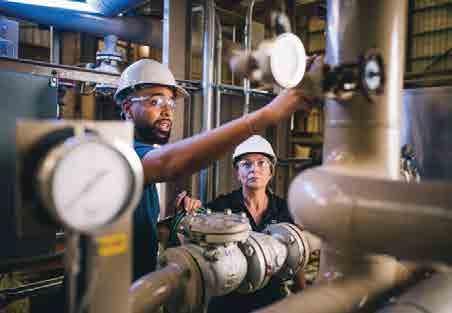
been released into the atmosphere, producing enough electrofuels to power vehicles in Amazon’s middle mile fleet for approximately 8 million km (5 million miles) per year.
The Infinium facility is due to begin production in 2023, and Amazon plans to begin using the electrofuels in the Southern California region initially.
“We all need to do our part to reduce greenhouse gas emissions and mitigate the effects of climate change,” added Schuetzle. “We appreciate how committed our industry partners like Amazon have been in embracing new technologies and we are confident that Infinium Electrofuels will play a significant role in our collective journey to a decarbonized, renewable energy economy.”
Amazon previously supported Infinium’s development of electrofuels technology through two rounds of investment through Amazon’s Climate Pledge Fund, a $2 billion venture investment program that specifically invests in companies building technologies, products and services that will help Amazon and others accelerate the path toward net zero carbon future.
While the new agreement is focused on providing Infinium Electrofuels for Amazon’s middle mile fleet, Electrofuels can also be used to power aeroplanes and used as an ultra-low carbon fuel alternative in the production of plastics and other industrial materials.
The car that cleans the air while driving
TU/ecomotive,a team of students from TU Eindhoven in The Netherlands, has developed an electric vehicle prototype which removes CO2 from the air as it drives.
Dubbed Zem, for Zero Emission Mobility, the two-seater resembles a BMW coupe and features two special built-in filters that capture up to two kilograms of CO2 over around 32,000 km (20,000 miles) of travel, by the team's estimates. The CO2 is then stored in the car until it can be disposed of. They imagine a future when filters can be emptied at charging stations.
“Our end goal is to create a more sustainable future,” said Jens Lahaije, finance manager for TU/ecomotive, the Eindhoven University of Technology student team that created the car.

Zem is powered by a Cleantron lithium-ion battery pack, and most of its parts are 3D-printed from recycled plastics, Lahaije said.
He added that the target is to minimise carbon dioxide emitted during the car's full lifespan, from manufacture to recycling.
Battery electric vehicles emit virtually no CO2 during operation compared with combustion-engine vehicles. However, battery cell production
can create so much pollution that it can take EVs tens of thousands of miles to achieve “carbon parity” with comparable fossil-fueled models. The students are showing their vehicle on a promotional tour of US universities and companies from the East Coast to Silicon Valley.
Industry Europe 53
NEWS
TRANSPORTATION
New developments in the Transportation
Linglong onto a Sustainable Future
Oneis to "accelerate digital development and build a digital China." Developing the digital economy is a strategic choice to accelerate industrial upgrading and achieve low-carbon green development.
As a leading Chinese tire manufacturing firm, Linglong Tire has adopted a comprehensive framework to embrace the transition with the support from seven major systems: R&D management PLM/ TDM, supply chain management ERP/SRM/WMS, smart factory MES/SCM, sales/after-sales/service system CRM/EDI, financial system SAP, organizational assurance, and management support BPM/ BI. Linglong believes that sustainable and responsible business increases our ability to innovate and add value to the company. The company focuses on building Hubei, Jilin, and European factories and aims to transform them into pioneering bases for intelligent manufacturing. They will become a benchmark for high-end smart manufacturing and green supply chain systems and provide a solid foundation for green and low-carbon development.
Environmental Strategy
The environment is a critical component of Linglong’s company policy, and the environmental strategy focuses on making business more sustainable across all aspects of the value chain.
• Organizational Environmental Protection
Linglong strictly implements national and local environmental protection laws and regulations in project design, construction, and production. All projects put into production have established a company-level environmental protection committee, introduced environmental management system standards, and systematically managed environmental factors to achieve the purpose of pollution prevention and environmental protection.
• Climate Protection
Linglong is committed to contributing to tackling climate change. Firstly, by operating on an energy-efficient basis, standardizing waste management, and meeting emission standards, Linglong further repurposes the energy produced in the waste management process. For example, the company designs the steam pipeline of tire vulcanization tail gas in a unified
way. And use the recovered secondary steam for raw material drying room, semi-finished product heating, staff bathhouse, workshop heating in winter, and production site cooling in summer.
Secondly, by developing products that help reduce CO2 emissions. The company aims to use raw materials as efficiently as possible and constantly innovate to create greener alternatives. For instance, the company actively expands the possibility of developing materials and focuses on research on low-pollution, low-consumption, and high-quality materials, such as bio-based materials, which are environmentally friendly, recyclable, and degradable. A series of innovative achievements in dandelion rubber, graphene tires, and 3D printing materials have been developed to help achieve the "dual decarbonization" goal. On October 16, 2021, Linglong Tire and Clintair signed a strategic cooperation agreement to plan tire retreading capacity in Jingmen, Changchun, and other factories, realize the recycling of carbon black in waste tires, and increase the recycling of waste tire resources. Maximize the value of tires, provide tire life cycle services, and empower the realization of low-carbon development.
• Product Responsibility
Linglong’s sustainability commitment to products covers their entire life cycle – from the raw materials used and product production to sales and subsequent recycling.
Linglong formulates a series of control standards and management processes for the material used in products and ensures the production of tires that meet environmental standards through clean production and safe supply chain development. All products meet customers' hazardous substance control standards or exporting countries and regions.

Linglong gradually strengthens the development of renewable and recyclable materials and their
application in tire products, reduces the dependence on petroleum-based materials, and continuously promotes the research and development of recyclable, renewable, and degradable materials to minimize harm to the environment. In recent years, the company has reduced carbon emissions by establishing a green supply chain system and the application of environmentally friendly materials and degradable materials. It has continued to promote innovative research on the application of dandelion rubber, graphene tires, and 3D printing materials to help achieve the "dual decarbonization" goal. It is planned that the proportion of sustainable resources and renewable materials in tires will reach 35% in 2025 and 40% in 2030.
Sustainable Governance
Linglong has ecological, social, and legal requirements for supplier selection and review. The company's suppliers and service providers must comply with the code of conduct, which encompasses requirements such as basic business ethics, anti-corruption, recyclable packaging, corporate social responsibility, and a certified quality management system. The company provides training programs with upstream and downstream firms, covering topics such as green environmental protection, decarbonization, and quality capabilities, cultivating supply capabilities, promoting longterm cooperation, and creating a competitive value chain. In 2018, we started to promote the green supply chain, and in 2021, 28 suppliers participated in the Linglong Tire green supply chain project.
Social Responsibility
As a dedicated member of the global community, Linglong demonstrates a sustainable commitment to social issues. The company actively advocates low-carbon development and promotes popularizing social low-carbon concepts. The company has also cooperated with domestic and overseas colleges, universities, and research institutions to jointly study green and low-carbon technologies, promote low-carbon ideas, empower environmental protection with scientific research, and help environmental protection with actions.
In 2021, Linglong deepened its cooperation with VfL Wolfsburg, the Bundesliga, and became VfL Wolfsburg’s official partner of the "race to zero" event by the United Nations.
54 Industry Europe NEWS
INDUSTRYNEWS
TRANSPORTATION
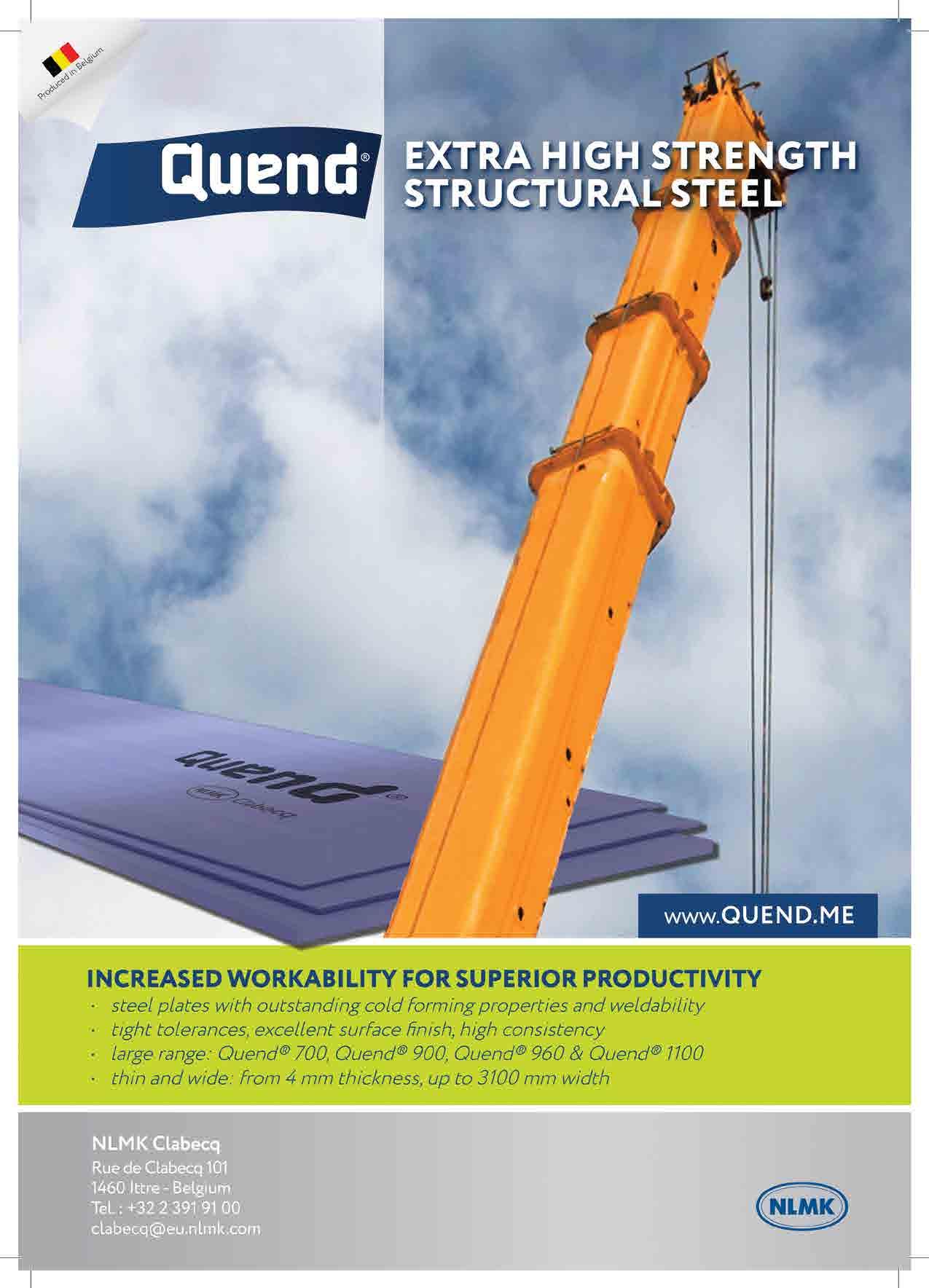





























 Giuseppe Santangelo
Giuseppe Santangelo






























































































































































